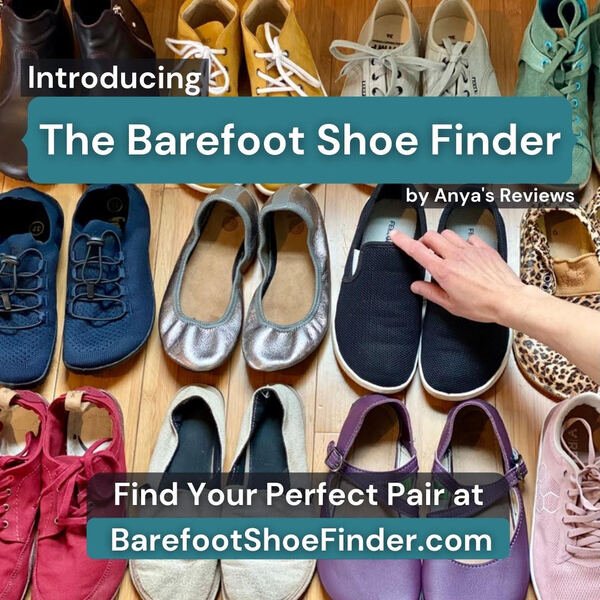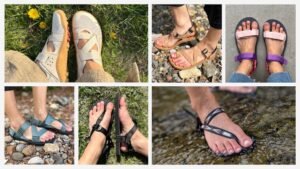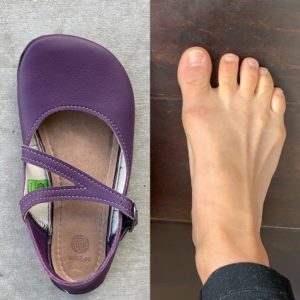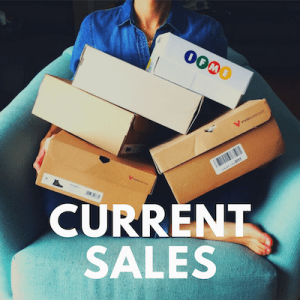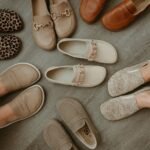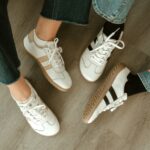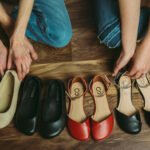The Barefoot Shoes FAQ - Your Ultimate Guide to Everything Barefoot & Minimalist Shoes
*Disclosure – Anya’s Reviews is reader-supported. When you buy through links on our site, we may earn an affiliate commission at no additional cost to you.
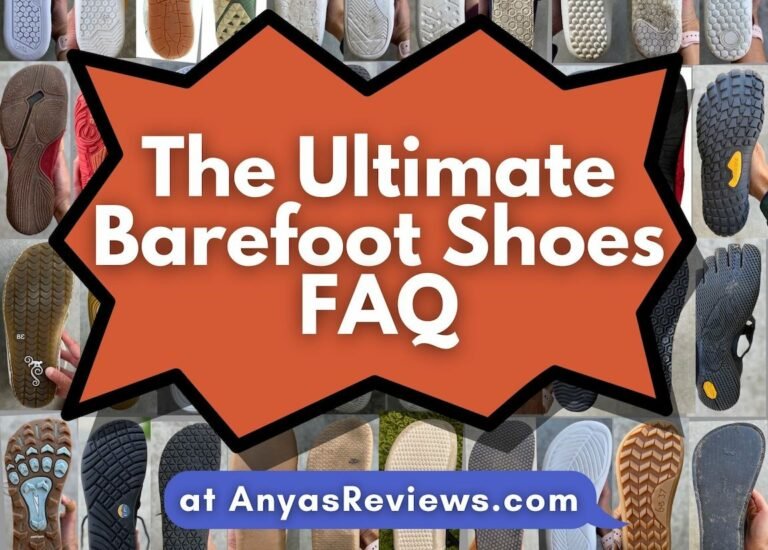
Welcome to the Barefoot Shoes FAQ! This is a collection of all of the common questions I get regarding barefoot shoes, from whether barefoot shoes are right for you all the way to hard-to-find barefoot shoe categories. From this page you can find all the resources you need to get started on your journey to happier feet and a stronger body.
Special thank you to Dr’s Andy Bryant and Ray McClanahan for their guidance on the clinical aspects of this FAQ.
*This is not a substitute for medical advice. This page is intended for educational purposes only.
1. Barefoot Shoes Overview
Barefoot (or minimalist) shoes are so called because they allow your feet to move naturally, the way they would if actually barefoot. The defining features of a barefoot shoe are that they have a foot shaped toe box, flexible sole, and no heel elevation (zero drop). Read this article for a more detailed breakdown of what is a barefoot and minimalist shoe.
Most people wear shoes for long periods of time every day. So when those shoes squish your toes and limit your mobility, the effects are cumulative. On the other hand, barefoot shoes preserve your natural foot function and can keep you strong and mobile throughout your life – barefoot and minimalist shoes are for people who want to use their feet forever. For more info, read this article on The Benefits of Barefoot Shoes.
Natural footwear (sometimes called “functional footwear”) is an umbrella term that generally refers to all shoes that let your feet move naturally. “Natural footwear” can range from an ultra-minimal sandal to a thick cushioned sneaker – but at a minimum natural footwear is zero drop (no heel elevation) and has an anatomical foot shape. Minimalist and Barefoot are terms often used to describe shoes that meet those same minimum requirements plus have a thin flexible sole. For more detailed info, read this article on the Benefits of Barefoot Shoes.
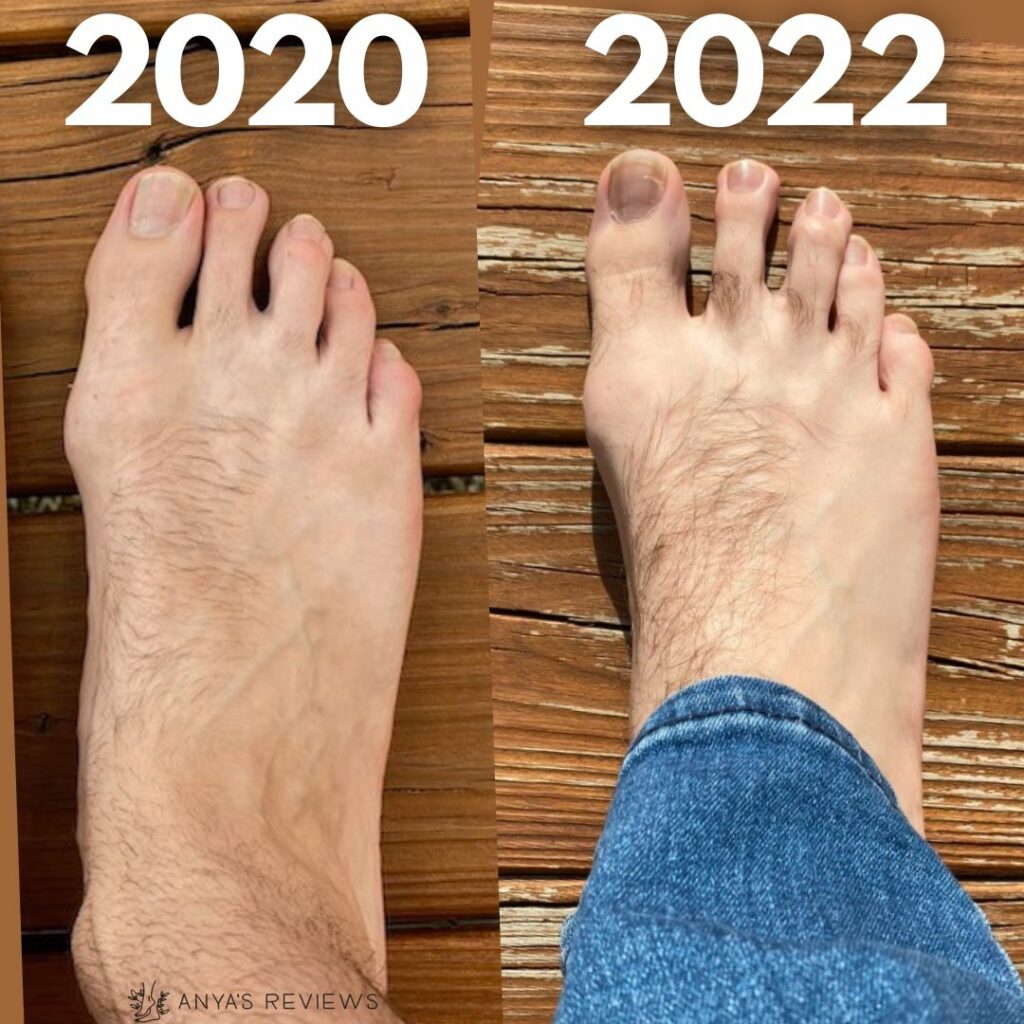
Once given space to spread out and move freely, feet can change in surprising ways. The most common visible changes are for the toes to spread out and the entire foot to widen and even lengthen. Very flat feet might actually shorten as the arch muscles become more active, and some people find they have a visible arch where none was before. Typically these changes happen slowly over time and in relation to how often you’re barefoot, in barefoot shoes, and/or doing foot exercises.
This can sometimes make buying shoes difficult and is one reason you may want to buy shoes wider than you think you need. But let’s celebrate the adaptability of the human body and that it can revert back to it’s natural shape! These changes are more than aesthetic – your feet are becoming more functional. And don’t forget that having a natural foot shape doesn’t mean you can’t rock the styles you love – that’s what Anya’s Reviews is all about, check out my barefoot shoe styling tips to get started.
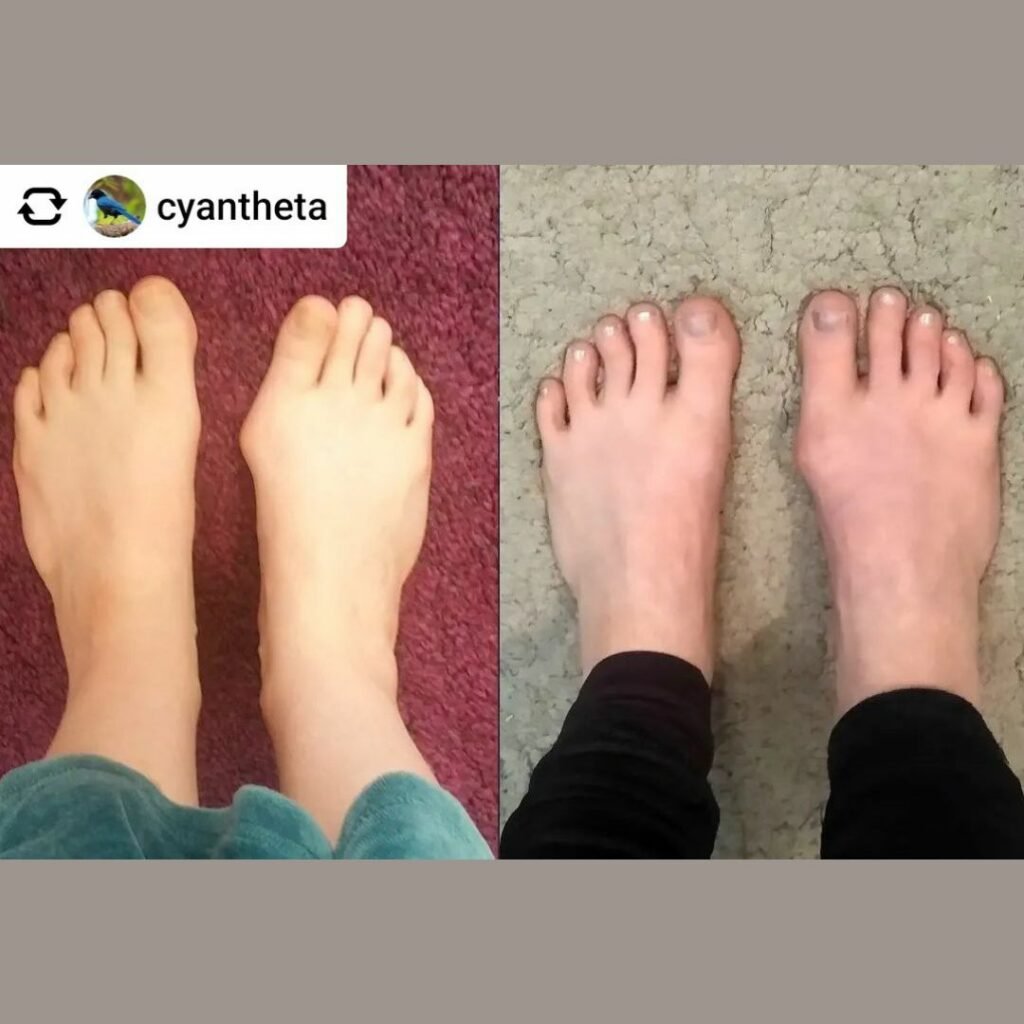
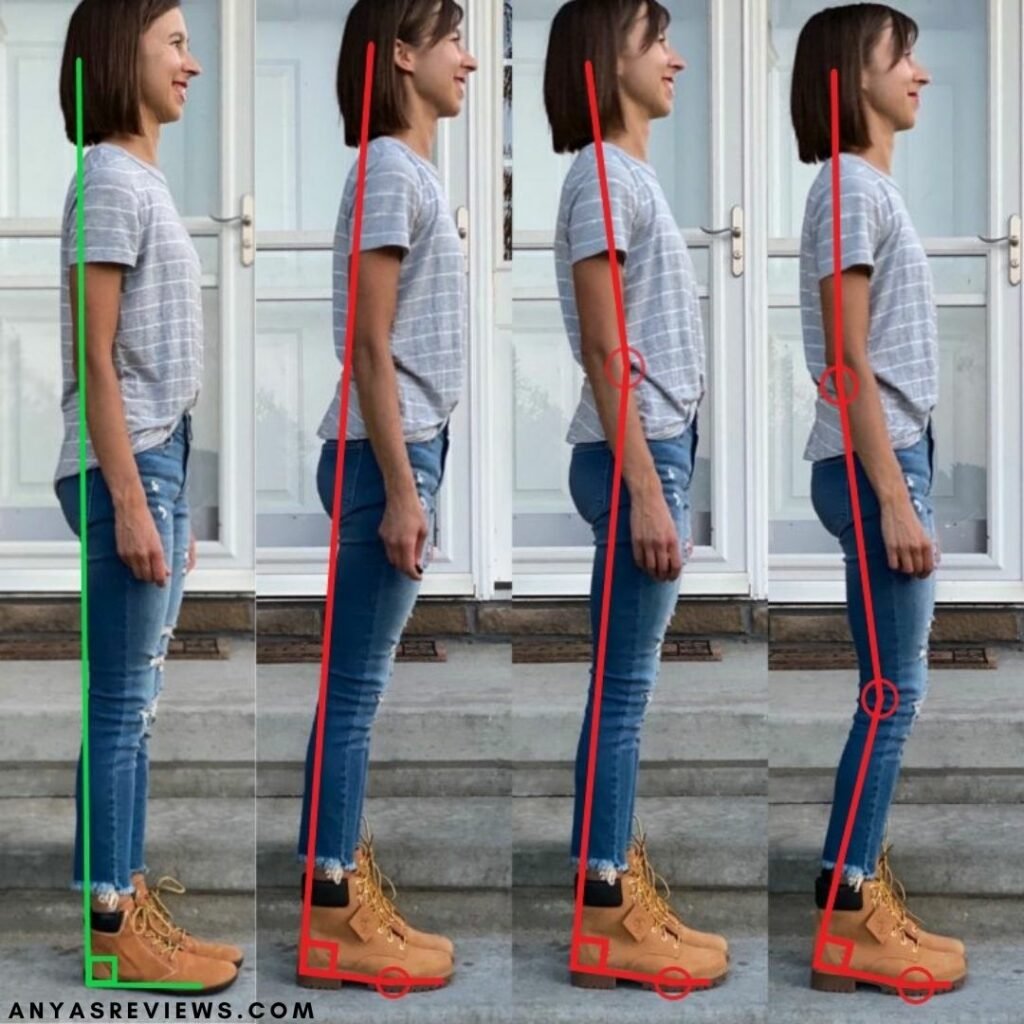
Barefoot shoes are zero drop, which makes it possible for you to stand straight with your body aligned. By contrast, most shoes you find in the store have a heel. Even most sneakers and ballet “flats” are not totally flat from heel to toe, which pushes you forward and requires compensations somewhere up the chain. This is why a totally flat sole is a non-negotiable feature of barefoot shoes, and it can improve your spinal alignment and alleviate back and neck pain.
To learn more about the features of barefoot shoes and why they matter, read the article on The Benefits of Barefoot Shoes.
Barefoot shoes push back against the notion that all feet need to be supported. They do not have arch support because they are designed to let your feet move freely and naturally. In fact, arch support removes the opportunity for your feet to support themselves, which can actually weaken the intrinsic foot muscles. In much the same way that wearing a brace or cast on other body parts for too long weakens those areas.
While it may take time, even people who have been reliant on arch support may be able to strengthen and rehabilitate their feet so that they no longer need it. If you have preexisting foot conditions it’s best to consult a physician – some feet need to be supported at least temporarily.
Refer to the section on Who Shouldn’t Wear Barefoot Shoes? for more information.
Further Reading:
Shoe drop refers to the difference in elevation between the toe and the heel. A zero drop shoe has no difference, the entire foot is the same distance from the ground – in other words it’s completely flat. That means that if a zero drop shoe is 10mm thick, it’s 10mm both under the ball of the foot and under the heel. Other terms used to describe the difference in thickness between the heel and the toe are “heel rise” and “heel to toe differential.”
You can find out why this matters in the How Do Barefoot Shoes Affect My Alignment FAQ.

Toe spring is when the front of the shoe, where the toes sit, curves upward. If this is rigid, then it perpetually forces the toes upward and can lead to an imbalance in the foot (overstretched plantar fascia, shortened extensors). Over time this can lead to foot pain and dysfunction. That’s why barefoot shoes have no rigid toe spring and are completely flat.
Note that the problem is when the toe spring is rigid. Many barefoot shoes get “acquired toe spring” after they’ve been worn. As long as the shoe flattens out when you stand in it, it shouldn’t be a problem.
2. Are They Right For Me?
Most otherwise healthy individuals are capable of transitioning to barefoot shoes. It might take time and supplemental training, but human bodies are highly adaptable and we were born barefoot after all. If you are able to wear barefoot shoes, it can help with many common foot and lower extremity issues, and may prevent future problems.
There is a commonly held belief in foot care that flat feet must be supported. But it’s unclear what exactly the definition of a flat foot is, and what complications it leads to. Arch support in traditional footwear does not teach you how to use your feet well and it doesn’t allow you to use your foot muscles, so it might actually hinder rather than help. Foot function is a much bigger indicator of success than the height of your arch. As long as there is no pain, dysfunction, or underlying pathologies, then both kids and adults can wear barefoot shoes even with flat feet.
Like with flat feet, there is a commonly held belief in foot care that high arches must be supported. But foot function is a much bigger indicator of success than the height of your arch. High arches might be an indicator that your foot is not mobile, and therefore might benefit from the flexibility of barefoot shoes. As long as there is no pain, dysfunction, or underlying pathologies, then both kids and adults can wear barefoot shoes even with high arches.
Plantar fasciosis (sometimes erroneously called plantar fasciitis) can be debilitating and difficult to treat, but proper footwear is a critical piece of the solution. Modern footwear with tight toe boxes and toe spring strain the plantar fascia and reduce blood flow – switching to minimalist shoes can help with that problem. But you might need additional foot training and professional help in conjunction with new footwear to fully recover.
Further Reading:
Treatment of Plantar Fasciosis – article by Dr. Ray McClanahan
Narrow Toe Boxes And Blood Flow – research study
Plantar Fasciosis – articles on different causes and treatment options from the foot health experts at Natural Footgear
Conditioning your feet to be strong, mobile, and stable is a long term solution to foot pain and injury, and barefoot shoes are a factor in that. Because most modern day footwear restricts motion and offers artificial support, switching to barefoot shoes gives you an opportunity to use your feet more. That naturally results in more strength and coordination. The zero drop soles in barefoot shoes also allow you to stand with better alignment, which can alleviate back and neck pain. But for many people changing your footwear is not enough. Barefoot shoes should be a part of a bigger understanding that we can improve our foot health through lifestyle changes.
You can find a list of foot conditions and suggested treatments here.
Further Reading:
The Foot Core System – research article
Walking in Minimalist Shoes Strengthens Feet – research study
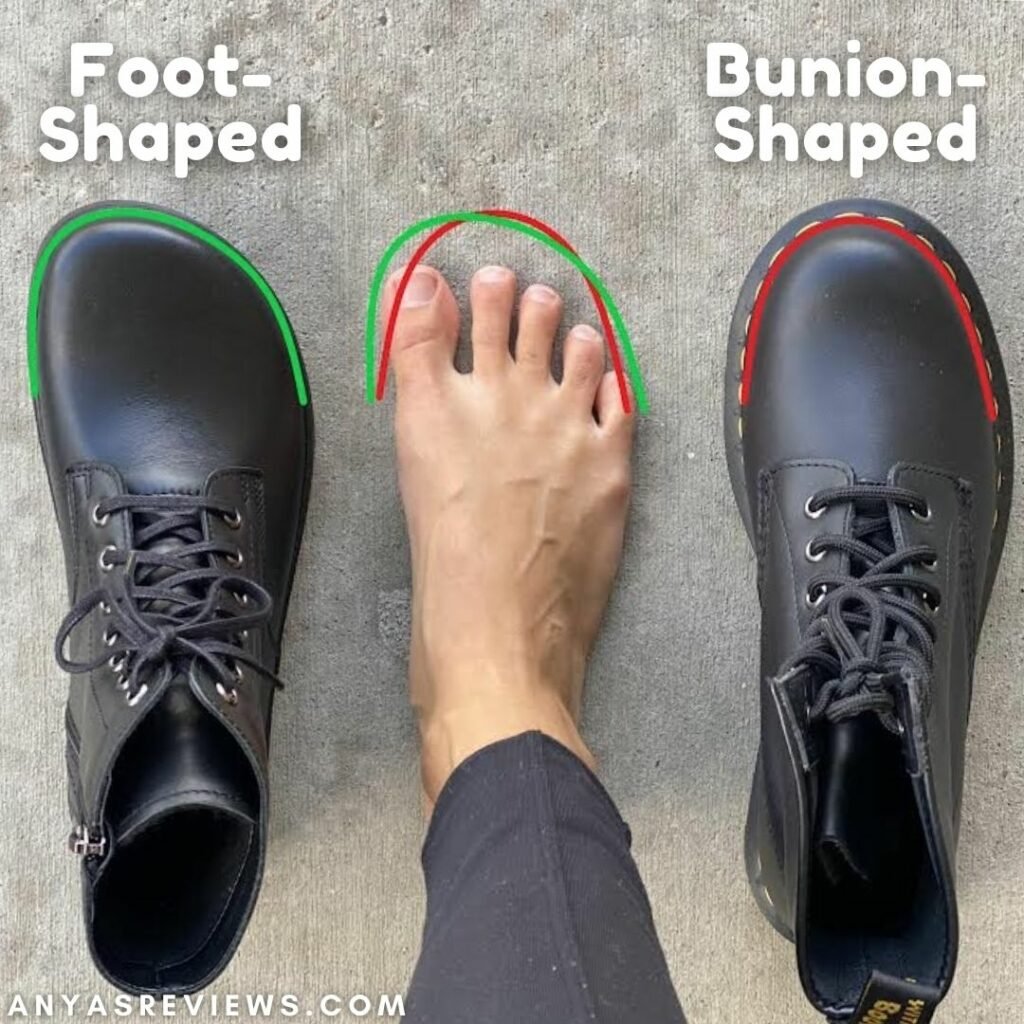
For a long time it was believed that bunions were genetic and nothing could be done about them. But evidence increasingly shows that bunions might actually be fact caused by ill-fitting shoes and lifestyle. If identified and treated early, bunions can often be completely reversed.
The anatomically shaped toe box in barefoot shoes allows the toes to lay straight (instead of being squeezed together), preventing further deformity and giving the foot the opportunity to realign. In addition to barefoot shoes, toe spacers and foot exercises can also help to improve the condition. Many people find that their symptoms go away as their foot health improves, but it does not always completely reverse the bunion and you may need to consult a medical professional.
For a deeper look at how to relieve bunion symptoms, read this article on
How To Help Your Bunions If You Don’t Want Surgery.
In general it’s best to use your body on a variety of surfaces and terrain, so as not to overuse certain parts. But if you have strong, conditioned feet then standing for long periods of time in barefoot shoes shouldn’t be an issue. However, if you are new to barefoot shoes and concerned about being uncomfortable, consider an option with a thicker sole to begin with or adding a barefoot insole (that has no heel rise!) to your shoes. Here are several barefoot shoe options with a sole thickness of at least 10mm.
You can also improve the natural padding on the bottoms of your feet by exposing them to different textures. Here are some tips for adding foot texture to your life.
Further Reading:
Muscle Use While Walking on Uneven Terrain – research study
Just like standing all day, hiking/running/walking long distances in barefoot shoes is fine if your feet are conditioned and prepared for it. But modern lifestyles make it difficult to achieve that, and many people doing huge mileage opt for more cushioned (but sill zero drop) shoes to begin with. If you have been moving for years in traditional athletic shoes with pointed toe boxes, arch support, and thick cushioned heels, you can injure yourself if you suddenly switch “cold turkey” to minimalist shoes. It’s a whole-body change and you may need to give yourself time to transition. The most important thing is to pay attention to your body and find what works for you.
Here are some barefoot shoe brands with thicker soles.
Seniors can wear barefoot shoes too! In modern western society an idea has taken root that advancing years means declining abilities. But we have learned from observation of non-western cultures and scientific research that this is not necessarily so – seniors can maintain and increase strength by exercising and/or not decreasing activity. This applies to feet in the same way – a young age is not a requirement to adapt to barefoot shoes. In fact, the flat and flexible soles of barefoot shoes might be especially helpful for older people who are at a higher risk of falling because they allow for more sensory feedback to the proprioceptive system. As with other medical considerations, you should consult with a medical professional for your unique needs.
Further Reading:
Exercised – by Daniel Lieberman
Falls Are Leading Cause of Death in Seniors – CDC article
Specific whole-body shifts induced by frequency-modulated vibrations of human plantar soles – research article
Keeping your kids’ feet healthy from the beginning is much easier than trying to correct a problem later, and most kids have no problem at all in barefoot shoes. In fact, many move more confidently and fall less in barefoot shoes than “regular” thick, heeled shoes!
It’s also normal for young children to have flat feet, and shouldn’t be a cause for concern unless they are having pain or dysfunction. If you’re concerned about your child’s development, see a physician.
Further Reading:
The Best Barefoot Shoes for Kids
The Barefoot Kids Shoes FAQ
Switching to unsupportive shoes with thin flexible soles can be a big change, and for some people it’s not advised to try it without professional/medical guidance. While most otherwise-healthy individuals can adapt over time to barefoot and minimalist shoes, if you have the following you might consider working with a professional:
- Ehlers Danlos/severe hypermobility
- Rigid musculoskeletal deformities
- Any pre-existing chronic foot condition
- Peripheral neuropathy
The irony here is that for some of these groups, minimalist shoes can be extremely beneficial! It’s just that you might want some help with the transition or at least to proceed carefully.
Despite the fact that the transition can be long and involved for some people, in most cases it’s a not a question of whether it’s possible, but whether you are willing to stick with the process. And don’t forget that it’s not an all or nothing deal – almost anyone regardless of their starting point can improve their foot health. A few ways to do this even if you meet the above criteria are:
- Choose shoes with a wider toe box. You can keep your support, cushion, and even a heel rise and still benefit from the toe space.
- Do basic foot exercises. These are very beneficial and available to most individuals.
- Provide safe sensory stimulation for your feet through Naboso products or with barefoot time (adapting this to your personal condition).
Click here for more detailed suggestions on how to naturally treat a variety of foot conditions.
Here are a few professionals who do virtual consultations and can advise you on your transition:
Gait Happens
Correct Toes
Ray McClanahan
Andy Bryant
Find more practitioners here
Yes you can run in barefoot shoes, but if you are used to running in supportive maximalist shoes it may require a change in form and an adjustment period. If you would like to adopt a natural barefoot running style, start with lots of barefoot walking first! Pay close attention to your body and give yourself time to adapt. While it may take time and dedication to relearn this natural movement, running in barefoot shoes can be injury free and enjoyable.
Additional Barefoot Style Running Resources:
Irene Davis on Running Injuries & Minimalist Shoes
Running Rewired, by Jay Dicharry
Run For Your Life, by Mark Cucuzella
Older Yet Faster, by Keith Bateman and Heidi Jones
3. How Do I Get Started?
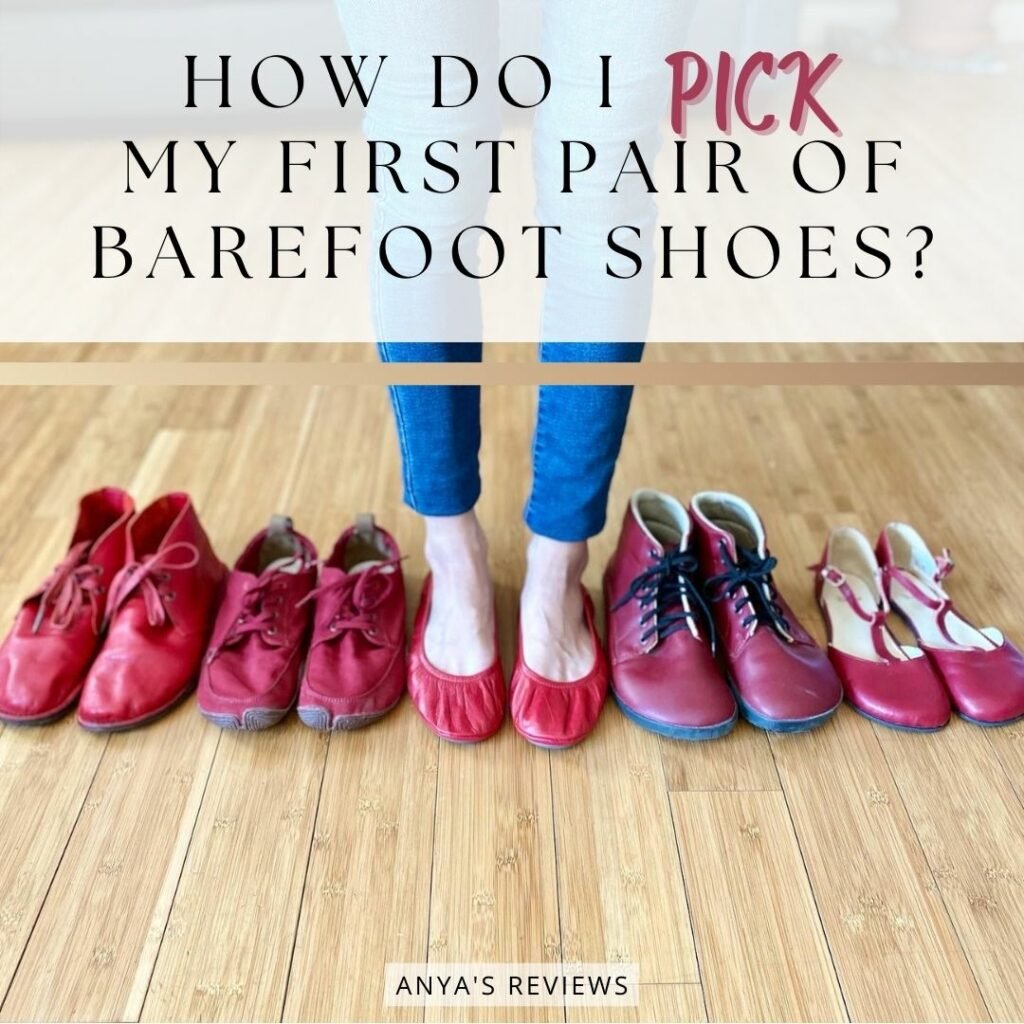
So you’re ready to take the leap! For your first pair of barefoot shoes, consider starting with a style you wear often and that will fit naturally into your life (if you never wear sneakers, don’t buy them!). Check out these extensive barefoot shoe lists for tons of options in different categories.
And you can familiarize yourself with the many minimalist shoe brands out there in the Barefoot Shoe Finder.
A few things to consider as you peruse brands:
- Cost: If you want your first pair to be low risk, use the Price filter in the Shoe Finder or try something from this list of Affordable Barefoot Shoes.
- Sole Thickness: You may want to start with a thicker soled minimalist shoe first – it’s not necessary but can make the transition easier. Specify the type of sole you want in the Shoe Finder Quiz, or check out this list of Beginner Barefoot Shoe Brands
- Location/Shipping & Returns: You can choose something close to home and/or with accessible policies to make the whole process easy. Read the brand policies outlined in the Shoe Finder.
- Shoe Size: You are likely to make some sizing mistakes at first – you may have been buying the wrong shoe size your whole life! Read my tips on getting an accurate foot measurement and consider options with no-hassle return policies.
A few other resources to help you out are these hundreds of barefoot shoe reviews, and this guide to the Best Barefoot Shoes & Brands For Your Foot Type.
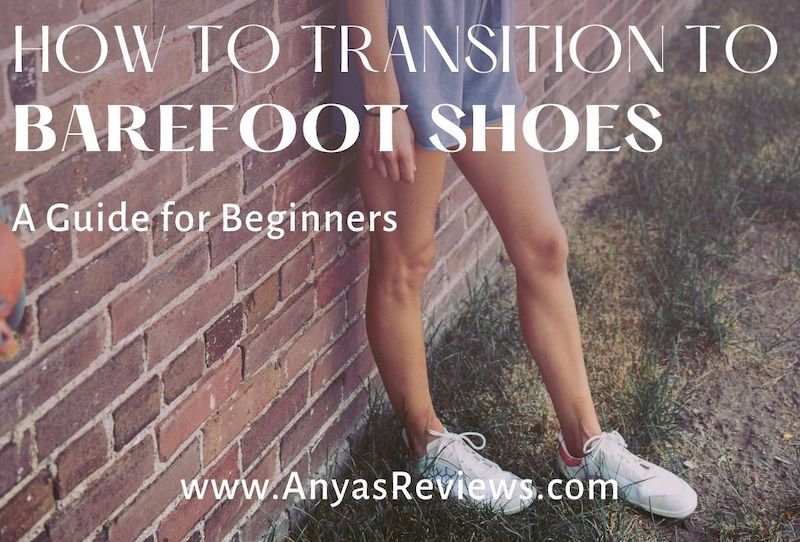
Transitioning to barefoot shoes is a process and will look different for every individual, but my #1 piece of advice is to start wearing barefoot shoes for only short periods at a time. See how you feel, and then slowly increase that time over weeks & months.
Zero drop shoes with a natural toe box make it possible to move naturally, but many people have weak intrinsic foot muscles and learned unnatural gait patterns (heavy heel striking for example) that carry over even in barefoot shoes. So you’ll have the best results if you consider other ways to improve your overall gait and foot health in addition to wearing better shoes.
Here are additional tips for transitioning to barefoot shoes:
- Add foot exercises such as these to your daily routine.
- Go completely barefoot often to naturally relearn functional movement
- Add texture to your indoor environments to stimulate the nerves in your feet
- Don’t be afraid to swap back and forth between your new barefoot shoes and your older supportive shoes.
- Consider a beginner barefoot shoe brand if you are uncomfortable in thin, minimalist soles. Insoles are also a good option.
- Remember it takes time for your body to adapt!
It might take several weeks, months or years for your muscles, ligament, nerves, and skin to adapt to the new stresses of being in barefoot shoes. This is why going slowly and carefully is often the best path. Give your brain and your body time to relearn how to be comfortable barefoot, and remember to walk before you run!
Barefoot shoes may not always feel comfortable as you walk and move around. This is ok – you can alternate between barefoot shoes and your old shoes as your body adapts. If you’re just looking for toe space, without the barefoot sole- check out this list.
If you are already used to being barefoot often and are physically fit, you may be able to switch over immediately. Biggest take away: Everyone is different. Don’t push yourself past pain and listen to your body if it’s telling you to slow down!
Check out the FAQ on How To Pick Your First Pair of Barefoot Shoes to get started.
List of Resources/Professionals Who Can Help the Transition Process:
- Find Your Footing Workshop – a collaboration between myself and movement expert Petra Fisher
- Walking 101 – Tips for walking well in barefoot shoes
- Whole Body Barefoot, by Katy Bowman
- Gait Happens My Foot Function Membership & Virtual Consultation
- NorthWest Foot & Ankle Virtual Consultation
- Gait Happens Certified Practitioners
- Healthy Feet Alliance Health Directory
- Whealth Free Foot Health Program
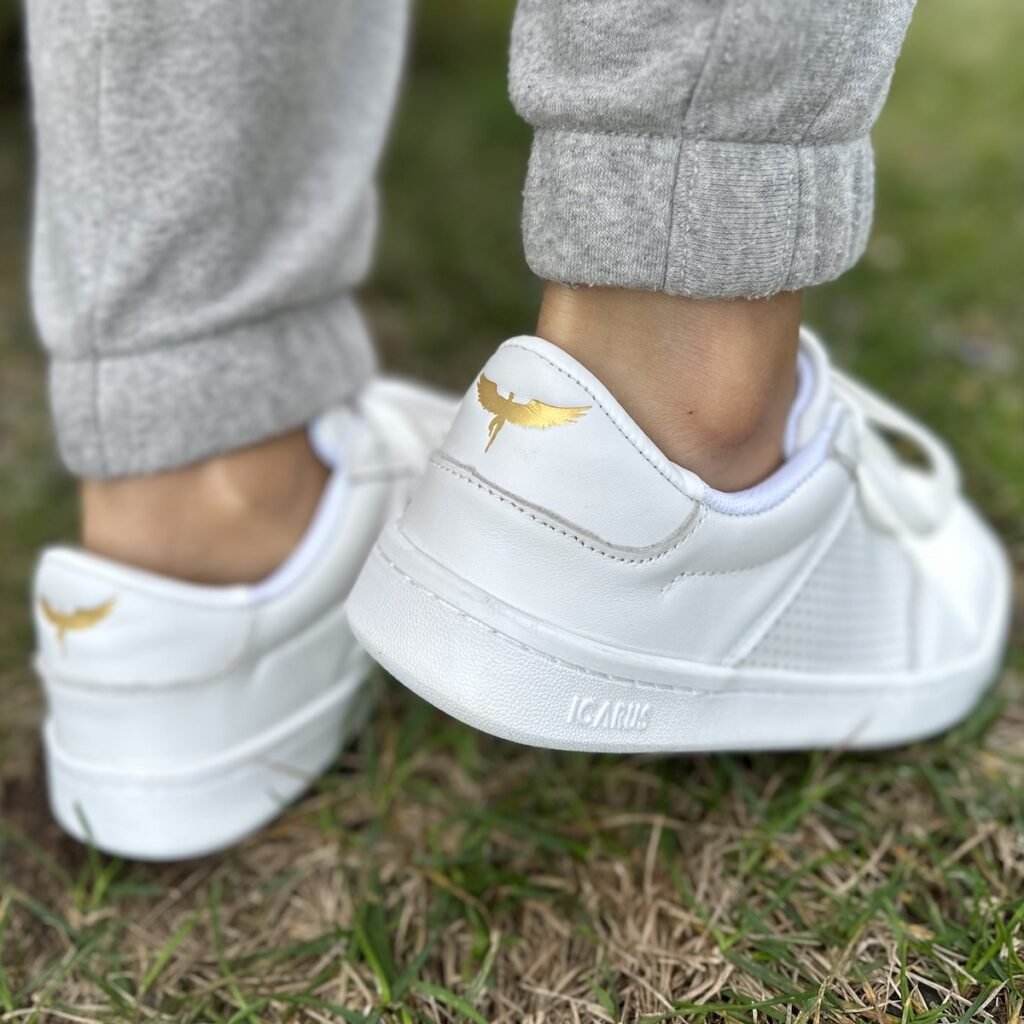
Some people transition to barefoot shoes overnight and never look back. Others take years to get used to it. The most important thing to understand is that ligaments and muscles take several weeks or even months to adapt to new stresses. If you’ve spent most of your life in restrictive footwear you may find that many new tissues are suddenly being used after lying dormant for years. It’s ok to switch back and forth between barefoot shoes and your old shoes, or to use arch support in barefoot shoes periodically to give yourself time to evolve. It will also take quite some time for the skin on the soles of your feet and the tissues between your bones to toughen and become less sensitive to pressure.
You can learn more about different pathways for transitioning to barefoot shoes in my Find Your Footing Workshop with movement coach Petra Fisher.
See How Do You Transition To Barefoot Shoes? for more info.
If you’ve begun to wear barefoot shoes only to start having pain, you might need to back off a little. Here are a few options:
- You can find a barefoot shoe with more cushion
- Add an insole to your existing barefoot shoes
- Switch back and forth between your usual footwear and your new barefoot shoes
- Do foot exercises to stimulate the nerves and strengthen your tissues
Pain signals are messages from our body, we should pay attention! Fortunately a few adjustments can often make a huge difference as your body adapts.
Don’t forget that it’s your feet that do the work (not your shoes), so adding in foot exercises and barefoot time on stimulating textures will strengthen and condition your body more quickly than with new shoes alone.
But if problems persist consider consulting a professional. See How Do You Transition To Barefoot Shoes? for a few recommendations.
Further Reading:
Barefoot Shoes for Beginners
Foot Exercises for Transitioning to Barefoot Shoes
It’s not necessary to switch all your shoes, but the more you are barefoot or in barefoot shoes, the more opportunity you have to strengthen, align, and stabilize your feet. And with the myriad of barefoot shoe options available today, you can be in natural footwear 100% of the time. But it takes time to transition your body AND your wardrobe. One easy way to make the switch is to buy barefoot shoes whenever you need to replace an old pair – you will naturally build up your options over time without straining your budget. If you keep a few “hurty” shoes in your closet for certain occasions, you’ll still be doing yourself a great service by wearing healthy shoes the rest of the time.
If you’re ready to get started, here is my guide to picking your first pair of barefoot shoes!
Because barefoot shoes are not often sold in physical stores, be prepared to order online. The first step is to measure your feet! Here are my best practices for accurately measuring your feet in order to pick a barefoot shoe size:
- I always measure my feet in centimeters to ensure an accurate number, and I measure before each purchase (in case my feet have changed).
- If you plan to wear socks in the shoes you’re purchasing you should have them on.
- Measure at the end of the day when your feet are biggest.
- If you are new to barefoot shoes, keep in mind that they may feel too big the first time you put them on. If they stay securely on your foot when you walk and don’t slosh around, that space around your toes is good and you probably picked the correct size!
- The general recommendation is to wear shoes that are 1 – 1.2cm longer than your foot, but it can vary significantly depending on your preference and the style of shoe. In slip on shoes I sometimes have only .5cm extra length so that they fit close and securely on my foot. In lace up boots that are highly adjustable, I am comfortable with as much as 2cm extra length. If the shoe matches your foot shape perfectly, less extra length is required (they’re foot gloves!). And all of this can be impacted by the design of the upper, the materials used, and your particular foot type and preferences.
Despite the inevitable variations, getting an accurate measurement and understanding a size chart can reduce the chance of sizing mistakes. There are two main ways to measure at home: A foot tracing and the wall method. Or you can skip both and purchase a measuring device!
In any case, for expensive/risky shoe purchases I always measure multiple ways TWICE in the evening. It’s ok if your measurements are slightly different every time, just use the average.
Foot Tracing
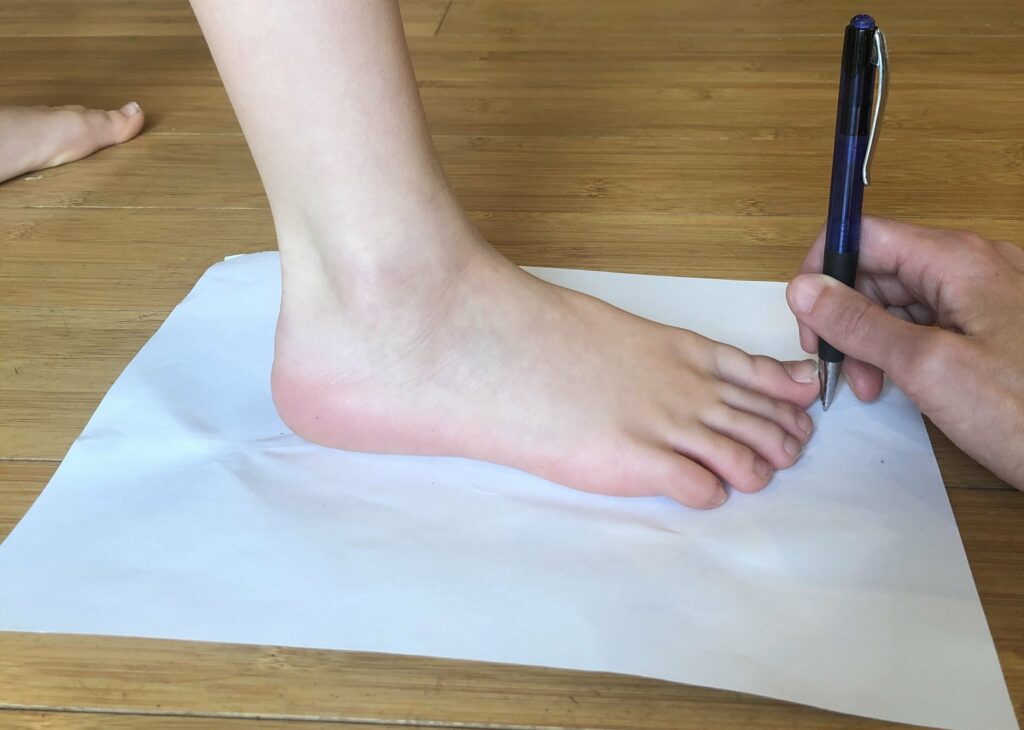
A foot tracing is the most common way to measure. You simply trace an outline of your foot and measure. But it’s important to know that it adds about .5 cm to your actual foot size.
So if you use a foot tracing to figure out what size shoe you need, take your measurement and add only .5 – 1cm (so the total shoe length you are looking for would then be 1 – 1.2cm longer than your actual foot size), and find the nearest corresponding size on the size chart. My feet measure 23.2 from a foot tracing, so I look for shoes with an internal length of 23.7-24.2.
Some people get confused about their foot width when they use a tracing, because they aren’t taking into account the extra mm the tracing added. My foot measures 9.2cm wide from a tracing but I can comfortably wear shoes that have an internal measurement of 8.8cm (without socks). This is because my actual foot width is .5cm less than the 9.2 I get from a tracing.
Wall Method
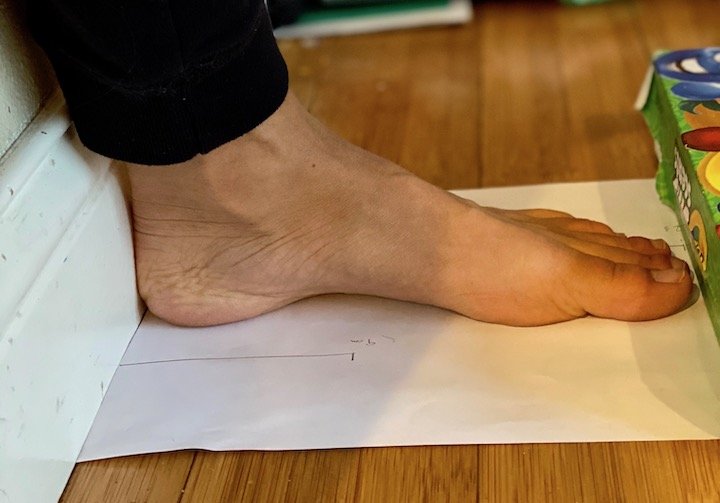
The wall method yields the most accurate length and width of your foot. You measure foot length by placing your heel lightly against the wall (don’t push it in) and putting a heavy book where your longest toe ends. Then mark where the book is and measure that distance. You get your foot width by lining up the outside edge of your foot against the wall and placing the book on the other side. Then mark with a pencil and measure.
You can find a video demonstration of how to measure your feet both ways here.
And if you’re now ready to learn how to interpret a size chart, head on over to that FAQ here.
Size selection is primarily done by foot length, but width does factor in (more on that at the end of the FAQ). To understand a size chart you first should read the instructions listed on the brands’ web page, because different brands create their size charts differently.
- If the size chart shows the length of the insole then you take your foot length and add roughly 1.2cm to it (or whatever your preferred extra length is).
- If the size chart shows the dimensions of the “last” used to mold the shoe then you follow the above instructions.
- If the size chart shows the length of the foot that fits in each size then all you need to do is locate the size that is closest to your measurement (but not smaller than).
If there are no instructions for how to use the size chart, contact the brand for clarification. But in my experience, when it’s not stated, the size chart shows the internal dimensions of the shoe and not the foot that fits inside.
In general, you want the internal length to be approximately 1.2 cm longer than your longest toe, but depending on the shoe anywhere from .7cm to 2cm extra length could work (for example, in dress shoes I prefer less space in front of my toes, but in boots or shoes I wear socks with I like more length).
Understanding Width in a Size Chart: Ok, width measurements in a size chart trip everyone up. I hear constantly from people who look at size charts and immediately say “these shoes are so narrow!!” It’s confusing because before wearing barefoot shoes many of us never even considered width! Here is why some of the widest barefoot shoes on the market might look narrow by the numbers.
- Unless you took a perfectly accurate Wall Method Measurement, the width of your pencil likely added some extra millimeters to your measurement. This may lead you to think you need shoes wider than you do.
- Width measurements are often taken from the insole, which sits underneath your foot in the bottom of the shoe – many barefoot shoes curve out away from the insole resulting in more usable space than the measurement suggests.
- Width can be taken at different places in the toe box of a shoe, and it might not line up with where you measured
- You don’t need as much extra space on the sides of your feet as in the front – you can often comfortably wear shoes close to your actual foot width.
Of course, this does not mean that you shouldn’t consider width. It is best to choose a shoe that fits both your length AND width, and I don’t recommend trying to squeeze your feet into a shoe that is too narrow.
But the truth is, size charts only take you so far. The shape and volume of your feet, as well as your personal preferences, all factor into what makes the ideal shoe for you.
I do my best to serve up the most practical barefoot shoe reviews and advice, but ultimately, you might need to try the shoes on your feet before you know if they’re a good fit.
4. Finding The Right Barefoot Shoes For Me
Once you start paying attention to your feet, you may find that not all barefoot shoes fit you well. Because shoes fit so closely to such a complicated structure (the foot) it can be difficult to find ones that match your particular shape and size. This guide helps you determine your foot type and the shoes that most closely match it, and you can also spend time perusing the many reviews and resources here to find feedback on each barefoot shoe brand. Ultimately, you will have to experience barefoot shoes to learn what you like/need in a shoe.
Barefoot shoes come in a variety of widths, so not all will fit you. Here are 3 resources to help you find options.
- You can find a list and visual comparison of the widest barefoot shoe options in this article.
- You can take the quiz at BarefootShoeFinder.com to get matched up with brands most likely to fit your feet. For your convenience, here is a list of brands in the Barefoot Shoe Finder tagged as “Extra Wide”.
- There are also many custom barefoot shoe options if you still don’t find what you need.
Having trouble with barefoot shoes being too wide for you? You can use the filtering options on the Barefoot Shoe Finder to browse options that fit a narrow foot. For your convenience, here are several brands from the Shoe Finder tagged as having narrow options.
Yes! Here are two resources two help you find brands and retailers near you.
- The Barefoot Shoe Finder – Enter your location in the quiz, and then you can filter by brands that “ship from” your location.
- The Barefoot Shoe Brands & Retailers By Region List – See it in list format in this article!
While thin flexible soles have benefits, you don’t need to start out with them if you don’t want to. In fact, a little cushion at first can make the transition easier as you relearn a more natural way of moving. In the Barefoot Shoe Finder quiz you can select the sole thickness you prefer and browse your options that way.
For your convenience, here is a list of barefoot shoe brands that carry options in 10mm thickness or more. Keep in mind that 10mm is still thinner than most athletic sneakers on the market today.
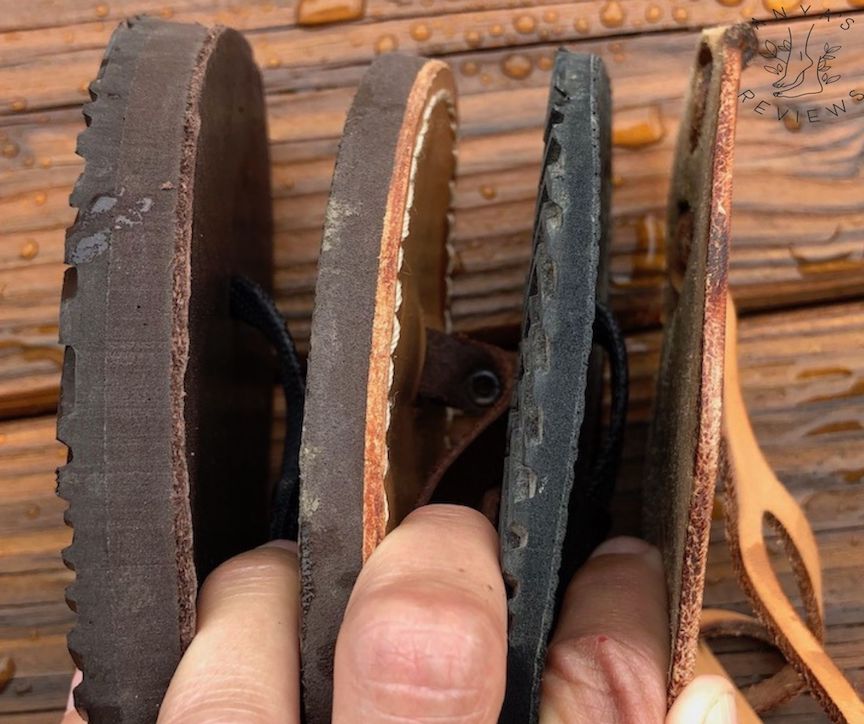
Absolutely! Though they aren’t usually called barefoot shoes, you can find natural footwear options that meet all the healthy shoe requirements but have some cushion.
This can be useful (but aren’t a requirement) if you are
- Transitioning to barefoot shoes
- Have pain standing all day
- Run/walk/hike long distances
- Have lost the fatty tissue on the soles of your feet
Here are a few of my favorites:
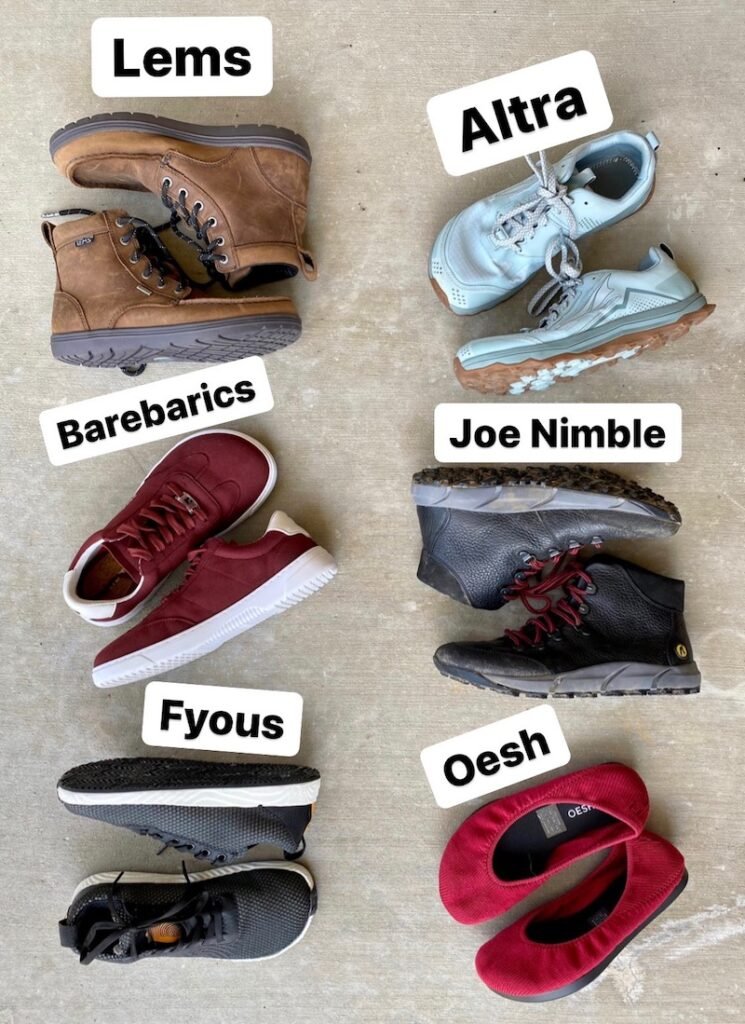
To learn more about these brands, plus find more cushioned options, read my Barefoot Shoes for Beginners Article.
If you’re looking for shoes with just a wide toe box and not a barefoot sole, check out this resource.
Cushioned shoes are not a requirement as you transition to barefoot shoes, but they are here for you if they meet your particular needs best. Read this FAQ to learn more about How To Transition To Barefoot Shoes.
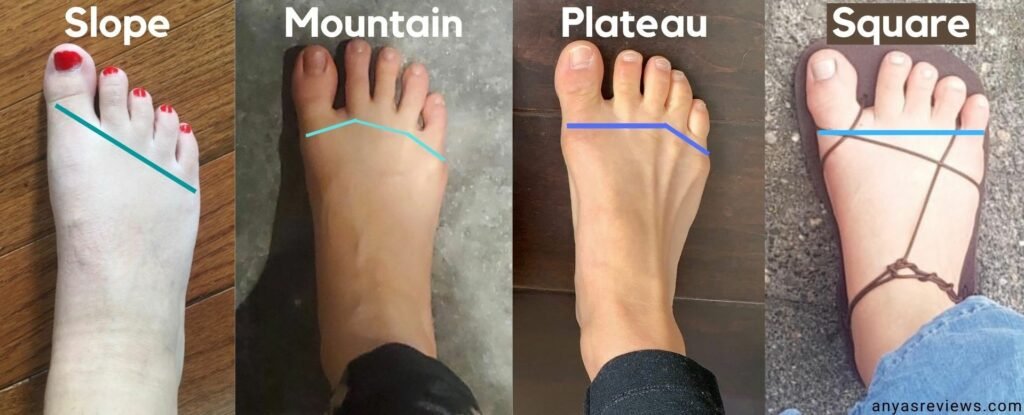
There are many ways to define your foot type. Here at Anya’s Reviews we use Shape (shown above), Width, and Volume to determine what to look for in a shoe. You can find a guide to understanding your foot type and the brands most likely to work for them here.
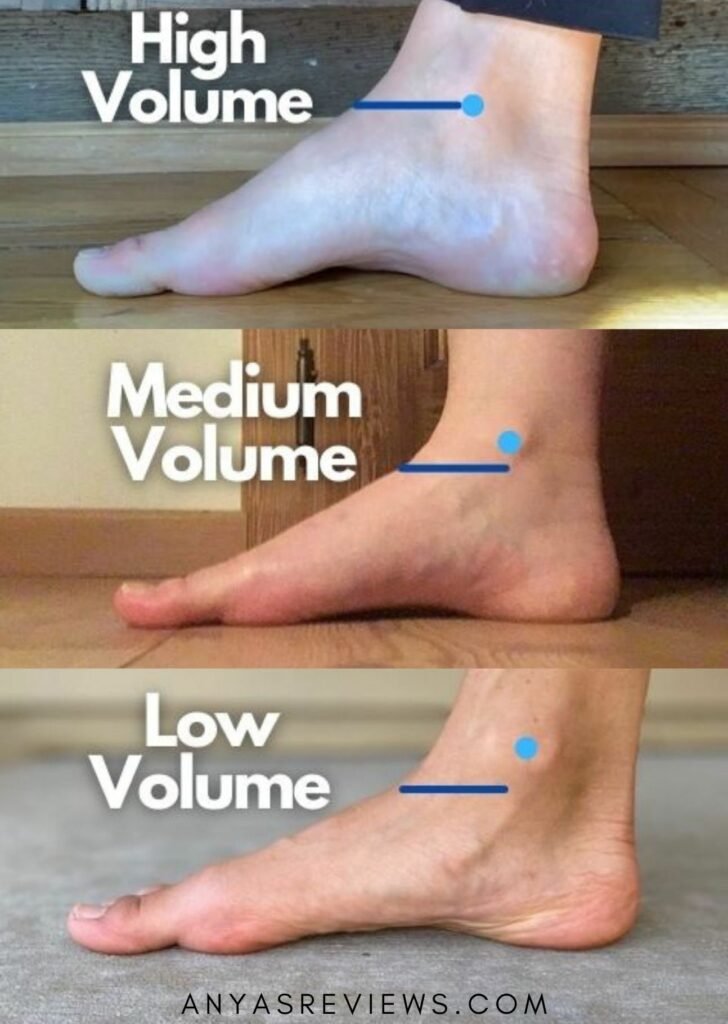
Foot volume is the amount of vertical space your foot takes up. This can be at any point along the foot, including at the arch or instep, the ball of the foot, or the toes. If your foot is “tall” in any or all of those areas it is high volume. If your foot is low to the ground or shallow, then it is low volume. This impacts shoe fit significantly, since some brands cater to low volume feet, others to high, and most to a middle ground. If you have high volume feet you may find that many shoes feel tight over the top of your foot. If you have low volume feet than you may find that shoes often slip around and you can’t get them tight enough over the top of your foot. Read this article for more information on foot volume + shoe options.
And refer to the Fit Hacks For High and Low Volume Feet in this FAQ for a few tricks.
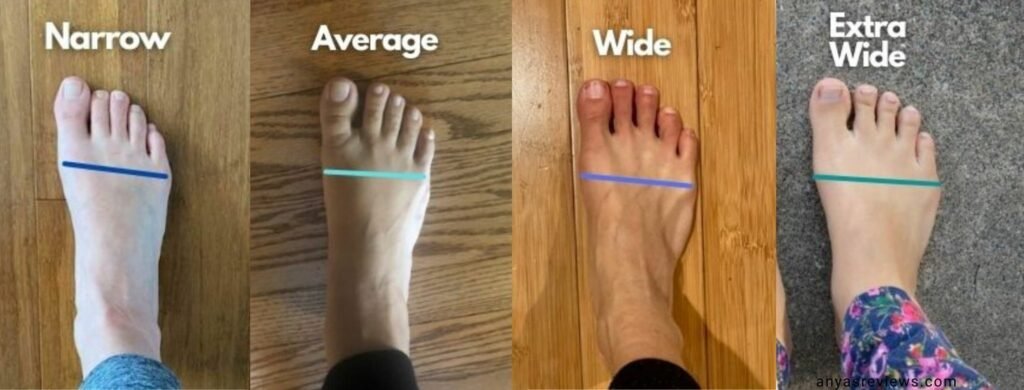
Shoes with tiny toe boxes have muddied the waters when it comes to foot width. Many people go through life thinking they have the widest feet in the world only to realize they’re actually average! When trying to determine your foot width, keep in mind that width is in proportion to length and that shoes get wider as you go up in size. It may take trying a few different barefoot shoe brands to determine where your foot width falls, but here you can find a general guide to foot width and barefoot shoe options in this article. And you can search for options by width in the Barefoot Shoe Finder.
There are some pretty dang cheap shoes out there in the world and barefoot shoe brands can’t always compete. Why is that? There are a lot of costs that go into manufacturing and marketing a barefoot shoe that most customers are not aware of – from custom lasts and molds, to labor costs for handmade products, and the fact that thin, flexible materials actually cost more to manufacture. Here is a thorough discussion of what it takes to make barefoot shoes and why they are sometimes more expensive than their non-barefoot counterparts.
But not all barefoot shoes are expensive, in fact many are comparable to other shoes on the market. Here you can find my Top 10 Affordable Barefoot Shoes for Adults.
And you can use the filters on the Barefoot Shoe Finder to browse by price range.
Wearing better shoes doesn’t need to cost an arm and a leg. Here are three resource to help you find cheaper barefoot shoe options.
- The Affordable Barefoot Shoes for Adults List that is broken down by price (starting at Under $25).
- The Affordable Barefoot Shoes For Kids List starting at Under $10
- The price range filtering options in the Barefoot Shoe Finder
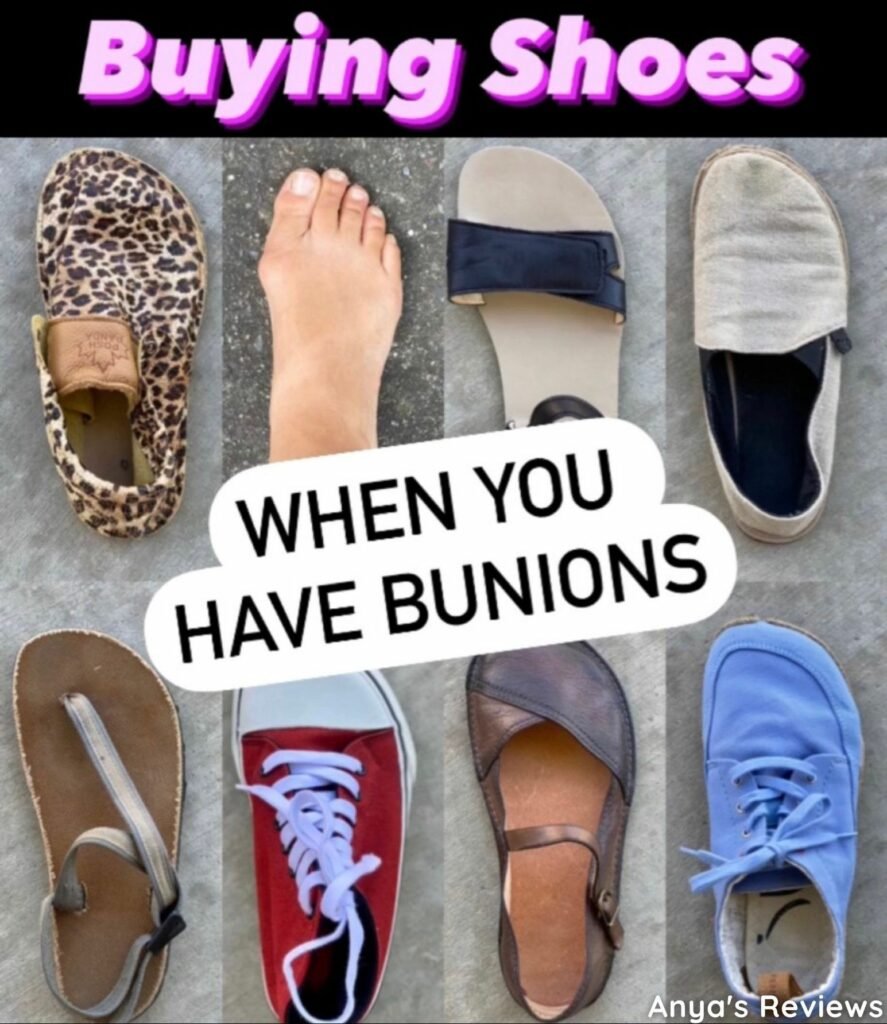
A bunion is when the metatarsal head (where the toe connects to the foot) moves away from the foot causing a painful protrusion. This can happen on both the big toe and the pinkie toe, and it makes shopping for shoes difficult. Here are some tips for finding barefoot shoes that work well with bunions:
- Look for wide, foot-shaped toe boxes even though it’ll give you more space than you need. Your toes may splay out over time, and it relieves pressure on the bunion.
- Choose shoes with a soft upper that spreads easily and doesn’t pinch while you walk.
- Look for shoes with soles that sit underneath the foot. If you want to try shoes that have a high walled sole, make sure they are wide enough that they don’t touch your bunions.
- Make sure the shoes are secure on your foot and don’t slide – running into the sides of your shoe can exacerbate the pain.
- If you are feeling discomfort from the thin soles or have limited range of motion in your big toe, adding an insole can provide cushion and support while still allowing your foot to realign itself.
It can also be really helpful to wear toe spacers inside your shoes – one more reason to choose extra wide shoes.
If for whatever reason you need/want a more structured shoe, go for extra wide options. Again, it’ll be more space than your toes need but will provide your bunion the clearance it needs. As long as the shoe fits securely around your midfoot, the extra toe space shouldn’t be a problem.
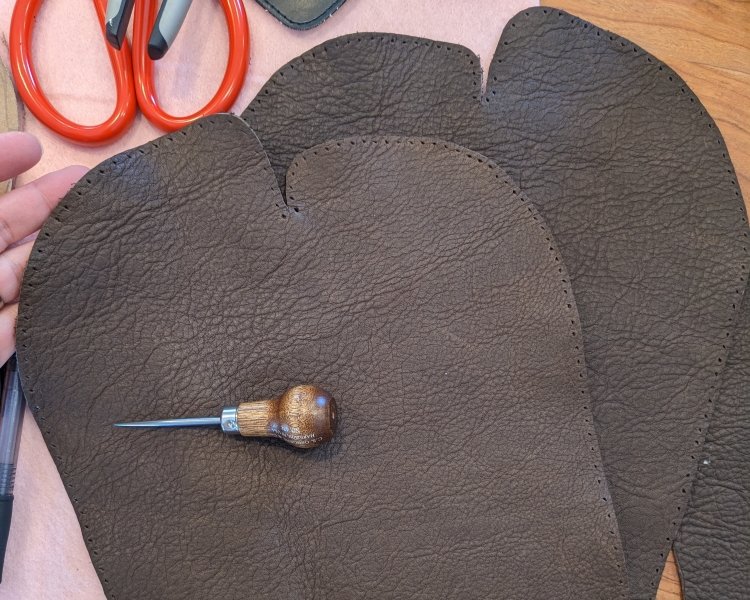
If you’re interested in DIY, there are quite a few resources available to help you!
- Earthing Moccasins Tutorials & Kits – Use code ANYASREVIEWS for 10 % off. Read about our experience here
- Xero Shoes DIY Kit
- DIY Moccs & Minimals – Facebook group dedicated to making minimalist shoes
- Dareen Shoe Making Courses – You can also find barefoot friendly shoe lasts here
5. Changing More Than Your Shoes
Socks do affect the function of your feet: they can restrict your toes just like shoes can and they cover your nerves inhibiting your sensory input. So finding time to be both shoe and sock-less is an important part of improving your overall foot health. Many people, myself included, often go completely barefoot in their shoes.
But if you want to wear socks, you certainly can! I wear socks in the cold months and sometimes to make my shoes fit better. It’s just a good idea to find socks that let your toes spread out so you get the full benefit of your foot shaped shoes. Find a list of many different foot-friendly sock options below.

Because socks can restrict your toes just like shoes can, it’s a good idea to look for socks with toe space. Toe socks let each toe move freely and are a great option for full foot mobility. There are also anatomical socks with a foot shape (unlike most socks, which are symmetrical). Find a list of foot-friendly sock options here.
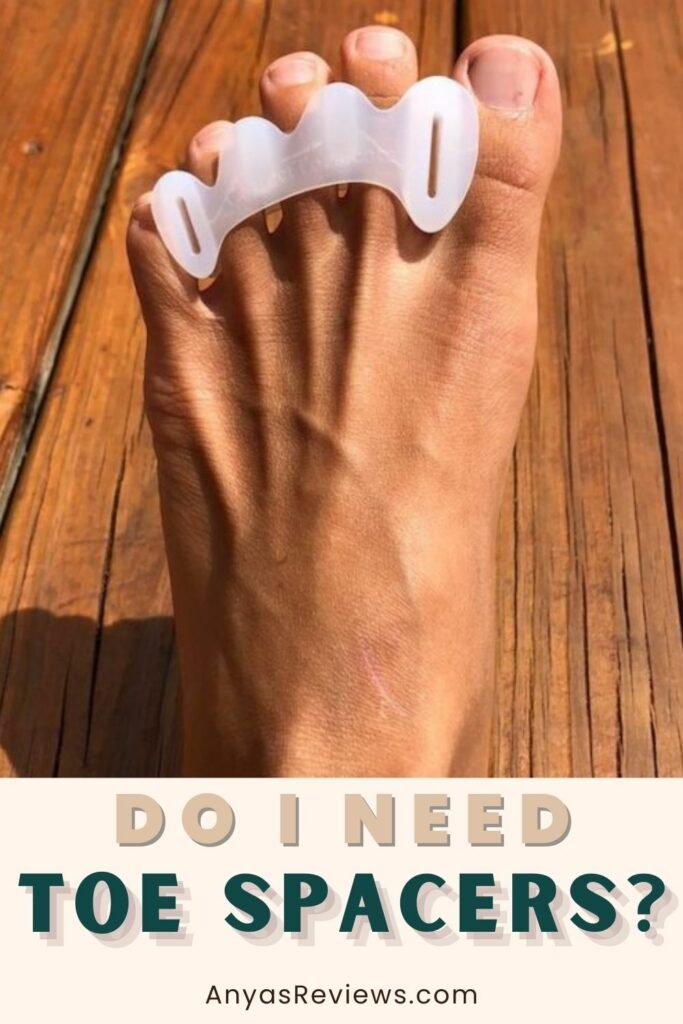
Toe spacers have myriad benefits for your feet and can help you transition to barefoot shoes faster, but they aren’t a requirement.
Here are some reasons to consider toe spacers:
- They help align the toes. When the big toe is aligned you can access your arch muscles better to prevent flat feet and knee cave. It can also bring pain relief from bunions and prevent further deformity.
- They break up dense tissue in the foot by spreading out the metatarsals. This can ease chronic plantar fascia pain and hammer toes.
- They bring blood to the foot, which speeds up healing and improves function.
While there are many options out there, I personally use and recommend Correct Toes. You can learn more about Correct Toes here.
Walking barefoot or in barefoot shoes is exercise for the feet! But you can get even more benefit and transition faster with additional foot strengthening exercises. They can be very helpful to retrain the brain to use your feet better. You can find 5 Simple Foot Exercises that can easily be added to your routine to improve your foot function faster. Another option I love is this free foot strengthening course from Whealth!
If you are looking to add more than just foot exercises into your life, I recommend checking out these coaches/programs:
- Restore Your Core with Lauren Ohayon
- Petra Fisher Movement
- The Body Coach
- Rmotion Coach
- Kathryn Blaze Fitness
- Strength in Motion PT
- Gait Happens
- Whealth – Use code ANYASREVIEWS for $200 off the Hypermobility Program

We gotta talk about skin during the winter. Air is often dry indoors then and that can lead to cracking and discomfort. While I don’t normally manicure my feet much (at all) I do try to keep my skin moisturized. Here is what I use:
- Cetaphil – this stuff is thick but it really works. Best applied before bed and/or you can put socks on to ensure it soaks in.
- Peace Roots Feet – this is a lighter moisturizer that can be used more often.
It also can be handy to keep a pumice stone. Skip exfoliating the whole foot – we like thick foot skin! – and instead only use it to keep skin cracks & corns (localized calluses) under control. This works best after a shower or bath.
6. Shoe Care and Fit Hacks
Barefoot shoes can last a long time if you care for them. Cleaning and conditioning leather shoes will keep them durable and nice for years, and if you live in a wet/snowy climate a little waterproofing can go a long way. It also helps to cover your shoes when not being worn to protect them from light and dust. You can read more about ways to preserve and protect your shoes in this article.
Shoes that are worn get dirty – here are some tips for cleaning them. If the shoes are extra delicate, colorful, or made of wool then I dry brush, spot clean, or hand wash in the sink as needed without product. This is often enough, but I sometimes use a dab of dish soap or leather cleaner.
If the shoes are very dirty or smelly, then I resort to fully immersing them in water or using the washing machine. Most shoe brands are wary of suggesting you wash your shoes in the machine, because they can get damaged. But I personally have washed many a shoe – even leather ones!
Here’s my formula:
– A drop of tea tree oil & a couple tablespoons of baking soda in each shoe
– Put shoes in mesh garment bag
– Dye & Scent Free Detergent (I use Trader Joe’s brand or soap nuts)
– Use Gentle Cycle or Delicate on the machine
– Air dry the shoes over an air vent
You can also scrub the inside with a brush (an old toothbrush works) to get rid of dead skin cells and any funk that has gotten into the materials. And if you use a removable insole in your shoes then it’s even easier to take it out to clean!
For more shoe care and fit tips, check out this resource!
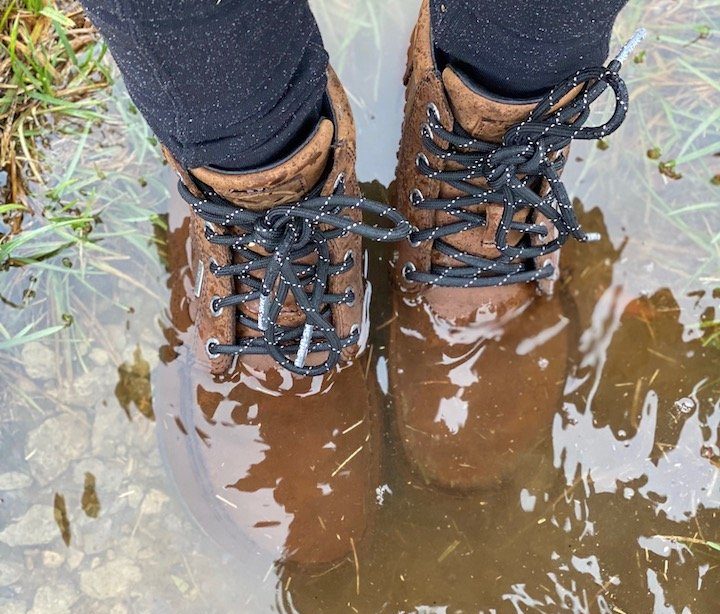
Barefoot shoes are meant to be functional, and for many people that means they need to withstand wet conditions. While you can buy waterproof and water resistant barefoot shoes, I find it very useful to have some waterproofing agents on hand because all waterproofing technology fails at some point.
And even if you don’t plan on standing in puddles, these tips will also protect your shoes from scuffs, spills, and dirt. So here’s how to waterproof & protect your barefoot shoes.
- Make sure that you clean your shoes and let them fully dry before treating them. A dry brush or damp rag is often sufficient, or you can use saddle soap on leather or GoGoNano cleaner on other materials.
- Choose your waterproofing products based on the material of the shoe. If I don’t want the look and feel of the shoe changed at all, then I choose a spray. If I want a more effective treatment and/or my shoe is unlikely to be affected by the treatment, then I go for a wax/oil based product.
- Test the product on a small, inconspicuous part of the shoe and let it dry for 24 hours to make sure you are happy with how it looks.
- Follow the product instructions to finish waterproofing!
- Reapply periodically. Sprays need to reapplied more frequently, waxes can go an entire season on one treatment.
Here are my preferred products:
Waterproofing Sprays
If working with suede, nubuck, fabric, or any light colored delicate material I use waterproofing sprays because it’s less likely to change the look and texture of the material. They do need to be reapplied every so often, especially after you clean your shoes or they get soaked .
- Carbon Pro – The most effective without changing the material in any way! Works on everything, including vegan and fabrics
- GoGoNano EcoProtect – Highly effective, and environmentally friendly.
- Nano Tech Waterproof Leather Spray – Have not used myself, but it comes highly rated
- Nikwax Footwear Care
– This is an ecofriendly spray, but it does slightly alter the look of suede/nubuck
Waterproofing Wax/Oil
These products have to be rubbed into the shoe and are more likely to affect the look, but they are often more effective as waterproofers. Best used on smooth leather/vegan leather products.
- Renapur Leather Balsam – This conditioner is a gentle waterproofer, not as effective as the below options. But really great for restoring the look of your shoes and increasing their longevity!
- Otter Wax – Works great.
- Sno Seal – Very effective, but definitely changes the leather (unless you are dealing with a very glossy finished leather to begin with).
Additional Waterproofing Hacks:
- Aquaseal – This is used to repair holes or seal up seams on your shoes!
- Neos Overshoe – This overshoe can be worn directly over your shoes to make them waterproof and slip-resistant (this is just one retailer, so you can search around to find your size).
- Waterproof Socks from Freet – Use code AnyaFreet for 10% off your order from Freet. Interesting idea to keep your feet, but not your shoes, dry!
Many shoes made of natural materials can stretch and conform to your foot over time. My rule of thumb is that if the shoe generally matches my foot shape and is only a little snug then it’s likely to become a good fit with a bit of work. If it’s shaped like an almond (with a pointed toe), if my toes are curling up at the edges, or if it feels really tight then I don’t waste my time trying to stretch. Here are my two favorite ways to stretch my shoes:
- Stuff the toe box with socks or newspaper and wave a hairdryer over it
- Push a golf ball or small rubber ball into the spot that I want stretched
- Use a wooden shoe stretcher
Shoes also naturally stretch as you wear them, so a slightly snug shoe made of leather or natural fabrics will likely become a perfect fit after a few wears.
If you have high volume feet and your shoes are too tight over the top of your foot but fit everywhere else you can try a few things:
- Size up – Depending on the shoe you may be able to size up for more vertical space and still get a good fit. This is most likely to work if your foot volume is predominantly in the instep.
- Stretch the shoe by strategically stuffing it and waving a hairdryer to warm up the material.
- Stretch the shoe with a wooden stretcher.
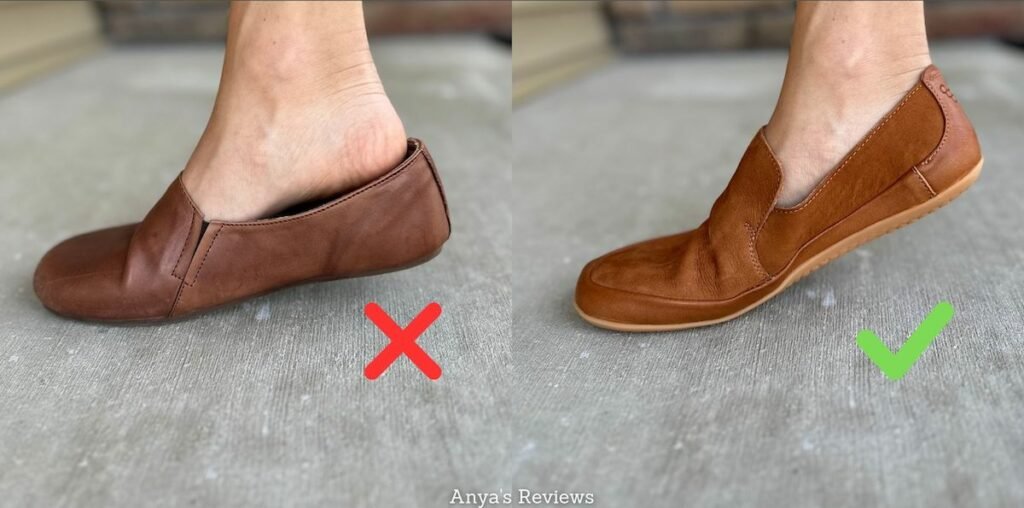
If you have a floppy shoe situation but it fits your length and width, here are a few things to try:
- Leg Warmers / Stirrup Socks – Works wonderfully in boots to fill up space but keep your toes free.
- Tongue Pads – My favorite low volume foot hack, but they are semi-permanent and will leave residue when removed.
- Foot Snuggs – This clever product is like a tongue pad, but can be worn inside your socks and comes in multiple lengths depending on the type of shoe you’re wearing them in!
- Heel Grip – Helps with heel slippage.
- Moleskin – This allows you to fill in a little space wherever it’s needed, even on sandals (because you cut it to fit).
- Barefoot Insoles – These work well if you have enough vertical space for them.
This is a common issue for people with low volume feet, but it can affect anyone depending on the type of shoe! Particularly with slip on and pull shoes, it’s a good idea to watch out for the dreaded flop. Fortunately, once you have a few items on hand, it is really easy to fix.
Heels slipping out of your barefoot shoes? This can affect your gait and should be addressed for maximum comfort. Fortunately a few fit hacks can usually solve the problem!
- Leg Warmers / Stirrup Socks – Works wonderfully in the cooler months to fill up space but keep your toes free.
- Heel Grip – My favorite trick for dress shoes.
- Moleskin – This is thinner than a heel grip and allows you to fill in a little space wherever it’s needed, even on sandals.
- Wear shoes with laces or straps that go over the arch to keep the shoe secure.
Barefoot shoes have thin soles, so it stands to reason that they would wear out more quickly than other shoes. I have found this to be sometimes true (if you’re comparing a Doc Marten or Timberlands sole to a 5mm layer of rubber, there’s no question which will last longer), but in general barefoot shoes last as long as other shoes.
Many barefoot shoe brands are using high quality outsoles that have been developed specifically to be thin AND durable (e.g., Vibram soles do an excellent job at that). And besides, many “regular” shoes are cheaply made and fall apart quickly.
How you use your shoes will have the greatest impact on how quickly they wear out, so if you’re concerned about this, choose an option with a thicker more durable sole. I include this information in all my barefoot shoe reviews to help you decide!
Currently there are just a handful of tall barefoot boots available, and they cater to an average calf width. Unfortunately that means you can’t currently find wide calf barefoot boots off the rack.
But here are three ways to make any of them work for your calf size.
- Add a Boot Band
- Take your boots to a local cobbler – many can add an elastic panel
- Order custom made boots (see this list off custom barefoot shoemakers)
Currently there are just a handful of tall barefoot boots available, and most cater to an average calf width. Two options that have a narrower calf width are the Peerko Regina, and the Angles Fashion Kairos. But here are two ways to get a perfect calf fit on your barefoot boots.
- Take them to a local cobbler – many can alter them to fit narrower
- Order custom barefoot boots (see this list of custom barefoot shoemakers for options).
7. Categories of Barefoot Shoes + Hard To Find Options
Have an uncommon shoe size? The Barefoot Shoe Finder is the best way to find options that come in your size. Simply enter your shoe size while taking the quiz. For your convenience, here are the brands that carry EU size 47 and above.
And if you are someone with small feet, here are the brands that carry EU 35 and smaller.
At first glance it might seem like most barefoot shoes are made of leather, but there are actually many vegan barefoot shoe options! Here are two ways you can browse vegan barefoot shoes:
- All my vegan barefoot shoe reviews are tagged here
- Or find all options in one place in my Complete List of Vegan Barefoot Shoes broken down by shoe style.
Praise the healthy feet gods, yes. You don’t have to suffer cold OR hurt feet during the winter months. Here are several barefoot boot resources to get you started.
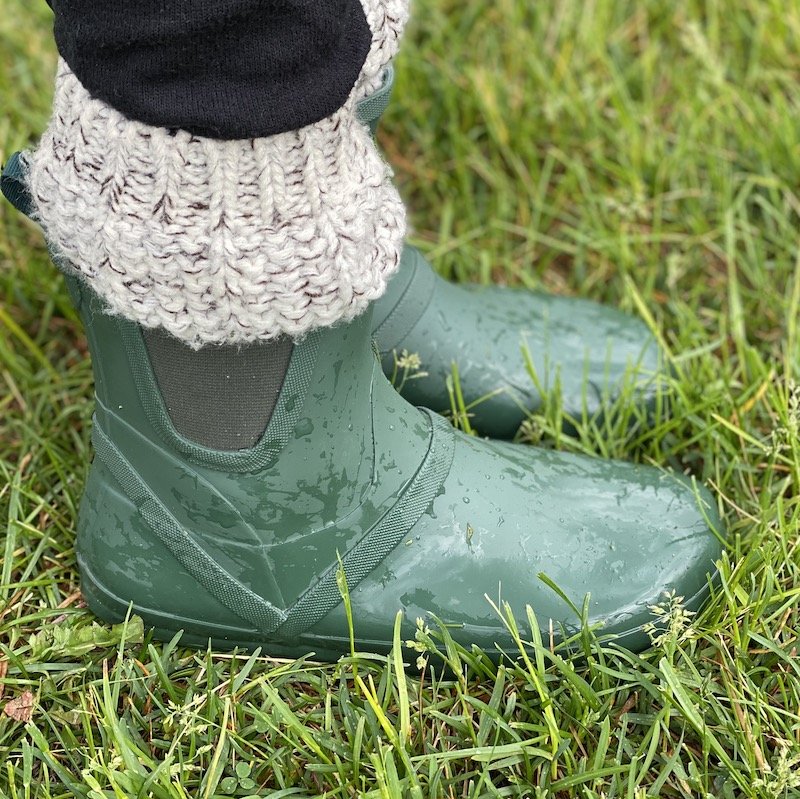
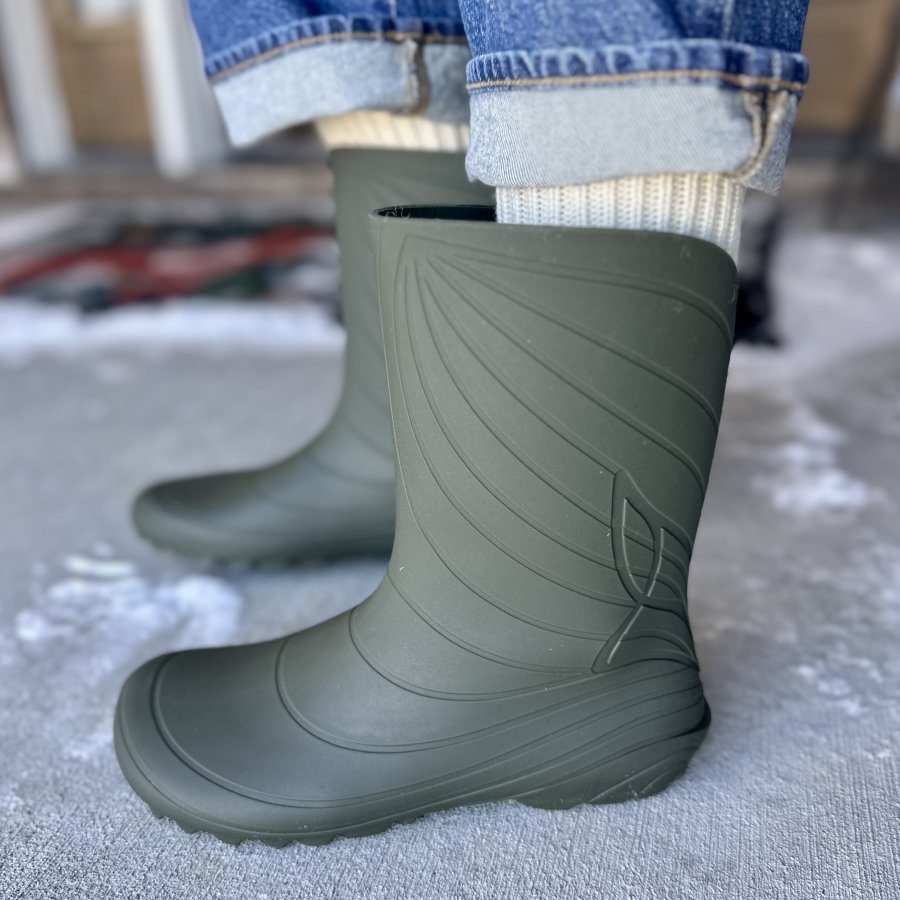
Yes there are! Here are the current best barefoot rain boots:
- Wildling Ranidae (adults & kids) – We love these! They have a generous toe box, but run a little big so size down if you’re between sizes. Use code AWN_ANYA_S for a one-time free shipping offer. If you’re outside the US/Canada, shop Wildling Shoes here.
- Xero Shoes Gracie (women’s) – A true barefoot rain boot! Read my review here. For those in the EU, shop Xero Shoes EU here.
- Saguaro Brisk – Use code ANYASREVIEWS for 15% off. Quite thin, but really great foot shape!
- Women’s Asgard (AMAZON) – Packable, affordable rubber boots that check all the boxes, but do have a narrower toe box than I prefer. Read my Asgard review here.
- Bisgaard (women’s & kids) – These rubber boots are completely flat and flexible but only go up to a size 40. US/Canadian customers can get them from Pedterra and use code ANYASREVIEWS, and the rest of the world can search for a retailer on Bisgaard’s website. Wider than the Asgard above, but just a little bit narrow.
- Pokeboo Packable Rain Boots – Men’s and Women’s – very minimal but have a narrower toe box. This is the truest barefoot rain boot that comes in men’s sizes.
- Vaistoa Katve – This Finnish brand only ships within Europe, but they look to be a perfect barefoot rain boot.
You can find even more waterproof and rubber rain boots that are barefoot friendly here! It includes kids rain boots too.

There has been some excellent growth in this area recently, so you have some good options! Currently our top pick for a steel toed work boot that is also zero drop and has a wide toe box is the Carets Determination Safety Boot.
For my full review of this barefoot friendly work boot plus addition options read this article on the Best Wide Toe Box Work Boots.

Thankfully you have several options to choose from if you need work shoes. Here are the best non-slip barefoot shoes for people working in restaurants, healthcare, warehouses or boating.
- Lems Kourt Grip – This same sole is also available on the Boulder Boot. They are really functional!
- Xero Prio All-Day SR – Read my review of them here.
- Birchbury Bramford – in black non-slip. These leather sneakers come with a removable insole that has a low drop, but can easily be replaced. I went up 1/2 size for more toe space.
- Leguano Care (EU) – Designed for healthcare workers. Use code ANYASREVIEWS for 5% off for retailer Mugavik.
- Birkenstock QO 500 – Non-slip work shoe that is zero drop with insole removed.
- Barebarics All Black Zing
- Astral Loyak – These are boating shoes with a grippy, non-slip sole. Remove the insole to be zero drop and note that they are a narrower option.
The following weren’t designed for industry workers, but still might work because they have a grippier outsole than most barefoot shoes.
- Groundies Original Sole – Groundies Barefootwear has 3 different outsoles. Anything made with the original GO1 sole is slip-resistant (but not non-slip).
- Bohempia – These are popular among skateboarders, and the slip-resistant outsole can also work for nursing/ food service.
- Xero Shoes 360 – These are meant to be grippy for quick lateral movement, but can also work in other situations!

Yes! There are many resources to help you find a dressy barefoot shoe for your occasion. Check the links below for lists and reviews of the best looking ones.
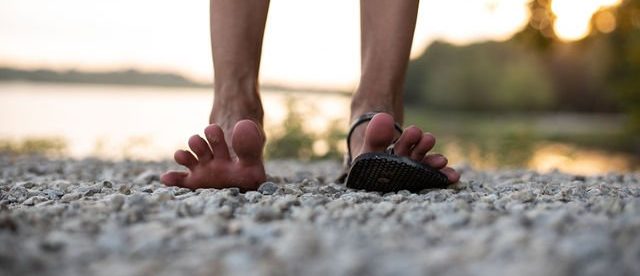
There are many barefoot shoes that have either conductive materials for grounding, or full leather soles. Here are a few options:
- Earth Runners – ANYA for 10% off
- FeelBarefoot – ANYA50 for 35% off regular price
- Earthing Moccasins – ANYASREVIEWS for 10% off
- Peracles
- Bahe – ANYA for 10% off

Many people are able to continue to use their barefoot shoes for casual sport play! Our personal favorites are the:
- Vivobarefoot Primus Trail for all outdoor sports
- and any Xero Sneakers for indoor sports!
But here are some more options for specific sports. And there are more foot-friendly sport shoes in the works!
- Baseball/Soccer/Football
- NaturAthletics cleat.
- Prevolve Footwear (custom cleats)
- Code Footwear – these are fully custom and quite pricey.
- Vivobarefoot Primus Trail – can pass for amateur soccer players and football
- Basketball/Court Sports
- Xero Basketball Shoes
- Uncivilized Sneakers (men’s sizes)
- Olympic Lifters
- Climbing
- Gym/Lifting Shoes: for a full review of our favorite barefoot gym shoes, read this article
- Xero Sneakers
- Vivobarefoot Motus Strength
- Notorious Lift – Use this link to get 10% off automatically
- Bearfoot Shoes
- Tolos
- TYR DropZero
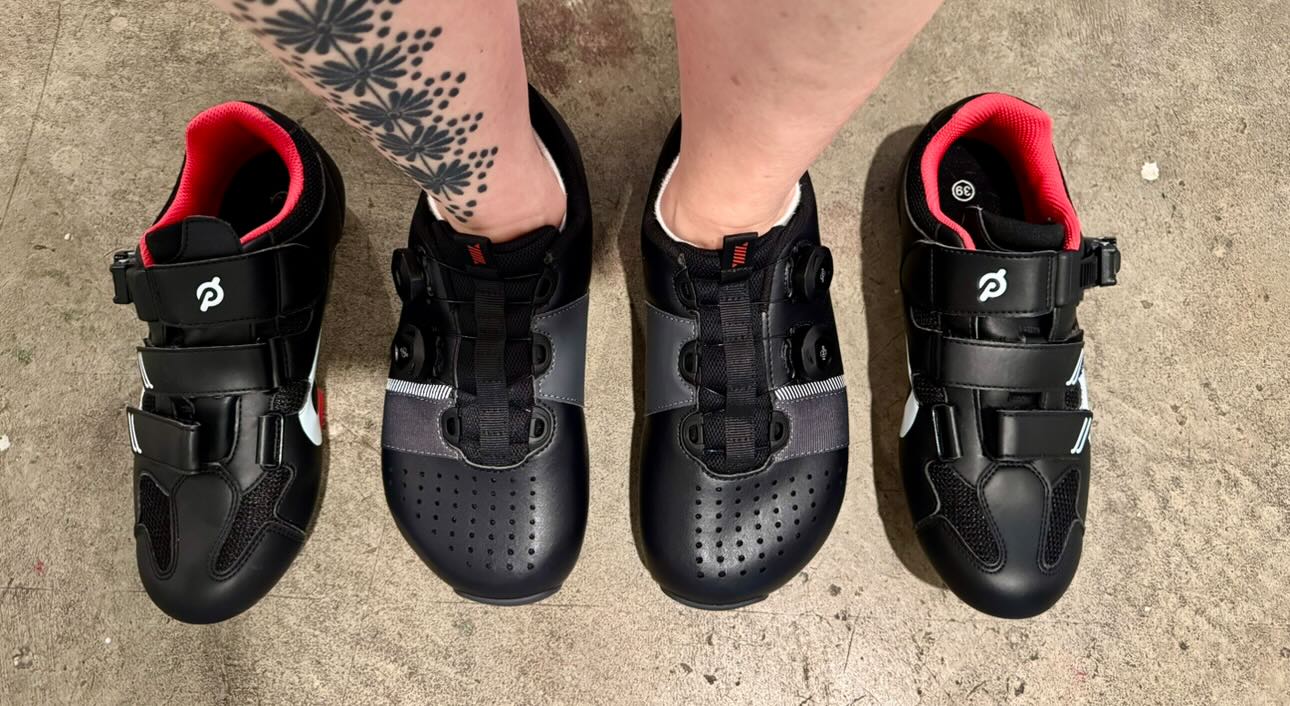
Currently there are a few cycling shoe options that are wider and more foot friendly than most.
- Strong Feet Athletics (shown above) – The best option for foot shaped cycling shoes
- Lake Cycling shoes come in widths, and you can search for Wide or Extra Wide options.
- And Bont Cycling shoes also have a wider and more natural foot shape to them.
Another option is to use platform pedals like this from Pedaling Innovations
I will keep you all informed of new developments! In the meantime, please share your experiences finding cycling shoes that don’t hurt your feet!

You can golf in many of the barefoot shoes listed on this website! But if you are looking for a shoe designed specifically for golf TRUE Linkswear has the current best options. Read our in-depth review of this barefoot golf shoe brand below.
Here are a few options that are approved by certain branches of the military that are better for your feet than the tradition heeled tactical boot. Most (if not all) have a very slight heel rise, but are as close to zero drop as you can get.
Tactical Boots:
- Belleville Mini Mil
- Reebok Nano
- Rocky SV2 – Composite toe option
Maritime Boots:

I get asked a lot if there are leather soled barefoot shoes for dancing and the answer is yes! Here are some brands that offer shoes with smooth leather soles for easy gliding on the dance floor:
Closed Toe Options
- Harlem Shoes – This dance shoe company offers a range of wide toe box dance shoes and they are beautiful! You can choose between zero-drop, or heel heights ranging from .5-2cm. You can find the men’s barefoot collection here.
- Softstar Shoes – The Ballerine model is available with a buffalo leather outsole
- FeelBarefoot – Use code ANYA50 for a discount
- The Drifter Leather
- Earthing Moccasins – Use code ANYASREVIEWS for 10% off
Sandal Options
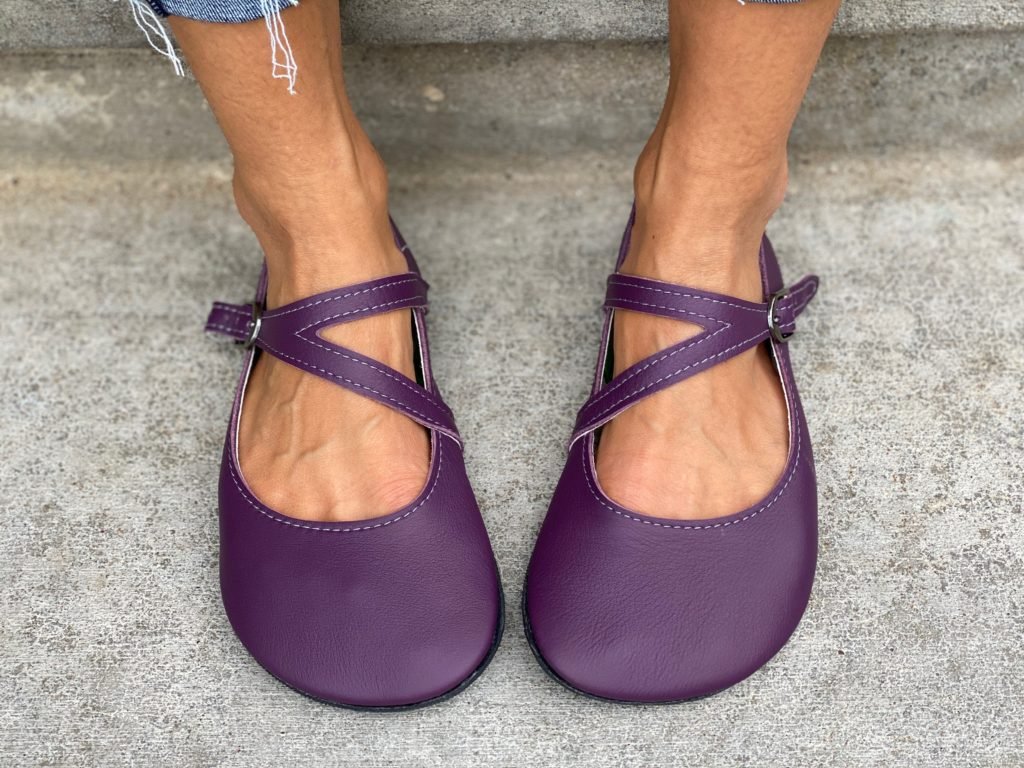
If you are someone who needs shoes in two different sizes, here are several barefoot shoe brands that make their shoes to order and can accommodate you. You just need to contact their customer service beforehand!
*This list is also where I recommend starting if you only need one shoe*
- Softstar Shoes (US)
- Aintap FeelBarefoot (Etsy, Turkey) – Code ANYA50 for 35% off
- Earth Runners (US) – Code ANYA for 10% off
- Shamma Sandals (US) – Code ANYASREVIEWS2023 for 10% off
- Deliberate Life Designs – ANYASREVIEWS for 10% off
- Everleigh Meadow (US) women’s and kids – ANYASREVIEWS for 10% off
- Unshoes (US) – ANYA for 10% off
- Senmotic (EU)
- Jenon Leather (EU)
Be aware that some of these brands might not accept returns on such an order, because they are unlikely to be able to resell them. So it’s a good idea to speak with them about their policies before purchasing.
You can find even more Custom Barefoot Shoe options here!
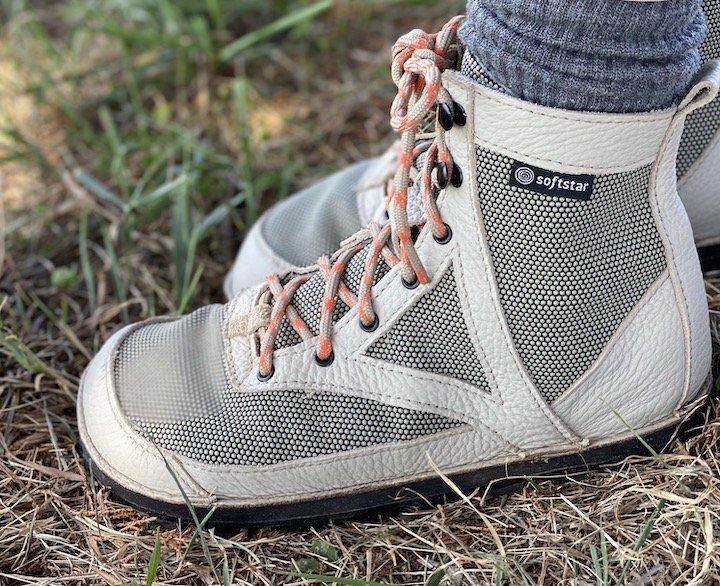
Yes! There are several barefoot shoe brands that are made right here in the USA.
- Butterfly Your World – ANYA10 for 10% off
- Deliberate Life Designs – ANYASREVIEWS for 10% off
- Duchess Barefoot – ANYA for 10% off
- Everleigh Meadow – ANYASREVIEWS for 10% off
- Luna Sandals – Not every model, but they’re labeled. Use code ANYASREVIEWS for 10% off
- Nativearth
- Shamma Sandals* – ANYASREVIEWS2023 for 10% off
- Softstar Shoes
- Toetem Sandals – ANYASREVIEWS for 7% off
- Unshoes – ANYA for 10% off
- Wild Poppy Shoes – Leather toddler sandals handmade in Idaho
Check out the full list of barefoot shoe brands and retailers in your region of the world here
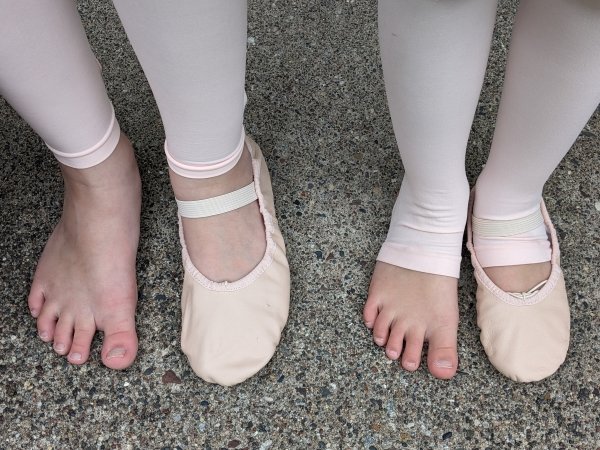
If you are looking for ballet shoes that are more friendly friendly for dance class, here are some tips:
- Shoes – Some studios will let you go totally barefoot for classes so it’s worth asking! Otherwise, there are brands of ballet shoes that come in multiple widths like Bloch listed below. Even though the toe box is tapered, the wider widths do give you more material around the outside of the shoes which give more space for the foot to spread out. The options from Oma King have a much wider toe box!
- Bloch Children’s Shoes
- Bloch Youth/Women’s Shoes
- Oma King Dance Shoes – Sizes EU 25-43
- Tights – If your studio allows, opt for footless or stirrup tights that won’t restrict toes.

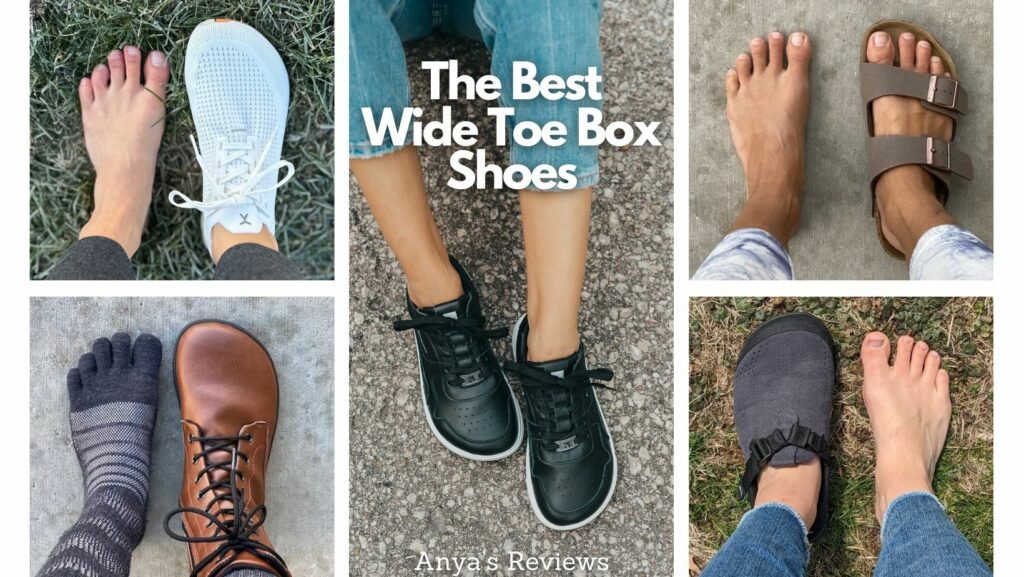
An anatomically shaped shoe that allows your toes to spread out is ground zero for foot health. So even though there are good reasons to consider true minimalist shoes, you should give yourself credit for taking what I would consider to be the most important shoe feature seriously! There are quite a few options out there for wide toe box shoes without a barefoot sole.

We love a good stretchy shoe! It can make finding a good fit a lot easier to have an upper material that’s forgiving like knit, and in the summer, they let your feet breathe. If you have bunions, these could be a good option to help prevent uncomfortable pinch points. We’ve rounded up all the stretchy sock-like knit shoes in the barefoot shoe universe for you below.

Freet – AnyaFreet for 10% off. Several models are a soft and stretchy knit. We especially like Pace and Howgill.

Lono Flow – ANYASREVIEWS for 5% off

Saguaro Free – ANYASREVIEWS for 15% off. These come in all sizes, my kids and I both love them. The Free and Smart model in my opinion have the best feel.

Vivobarefoot Motus Flex – ARVIVO20 for 20% off
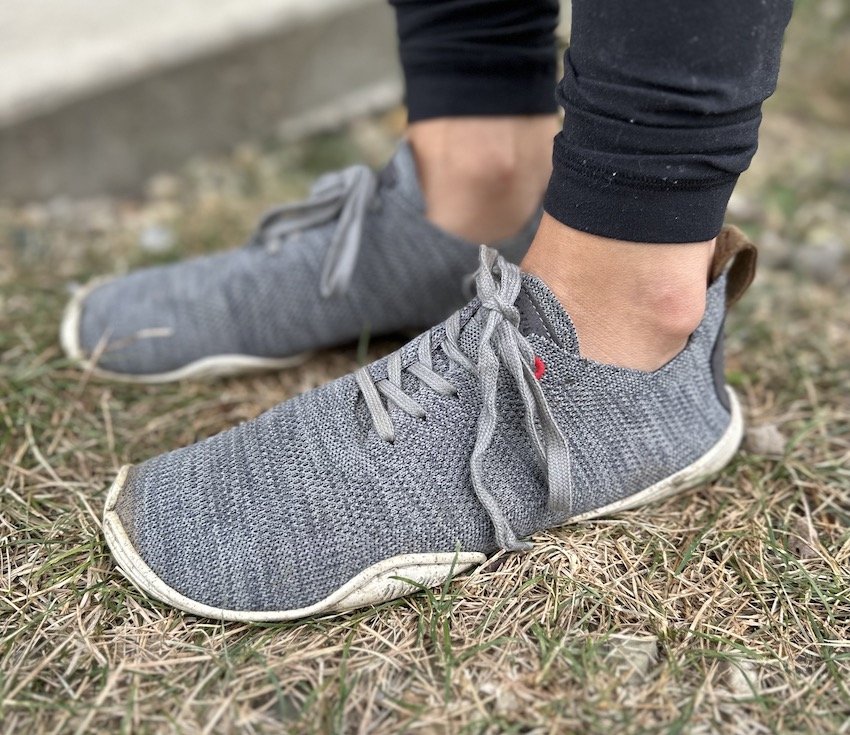
Wildling Shoes Nittugo – AWN_ANYA_S for a one time free shipping offer. If you live outside the US/Canada, shop Wildling Shoes here.

Reima Astelu – ANYA20 for 20% off your first purchase. We find these to run a little big. But the quality and comfort are excellent for the price – our team is really loving them for kids of all ages.
Others that are nice and easy to wear, but a little more structured and not as sock like are the following:
- Xero Shoes Dillon and Nexus
- Feelgrounds Original Knit
- Be Lenka Stride – ANYASREVIEWS for 5% off
8. Barefoot Shoes for Kids
Keeping your kids’ feet healthy from the beginning is much easier than trying to correct a problem later, and most kids have no problem at all in barefoot shoes. In fact, many move more confidently and fall less in barefoot shoes than “regular” thick, heeled shoes!
It’s also normal for young children to have flat feet, and shouldn’t be a cause for concern unless they are having pain or dysfunction. If you’re concerned about your child’s development, see a physician.
Further Reading:
The Best Barefoot Shoes for Kids
The Barefoot Kids Shoes FAQ
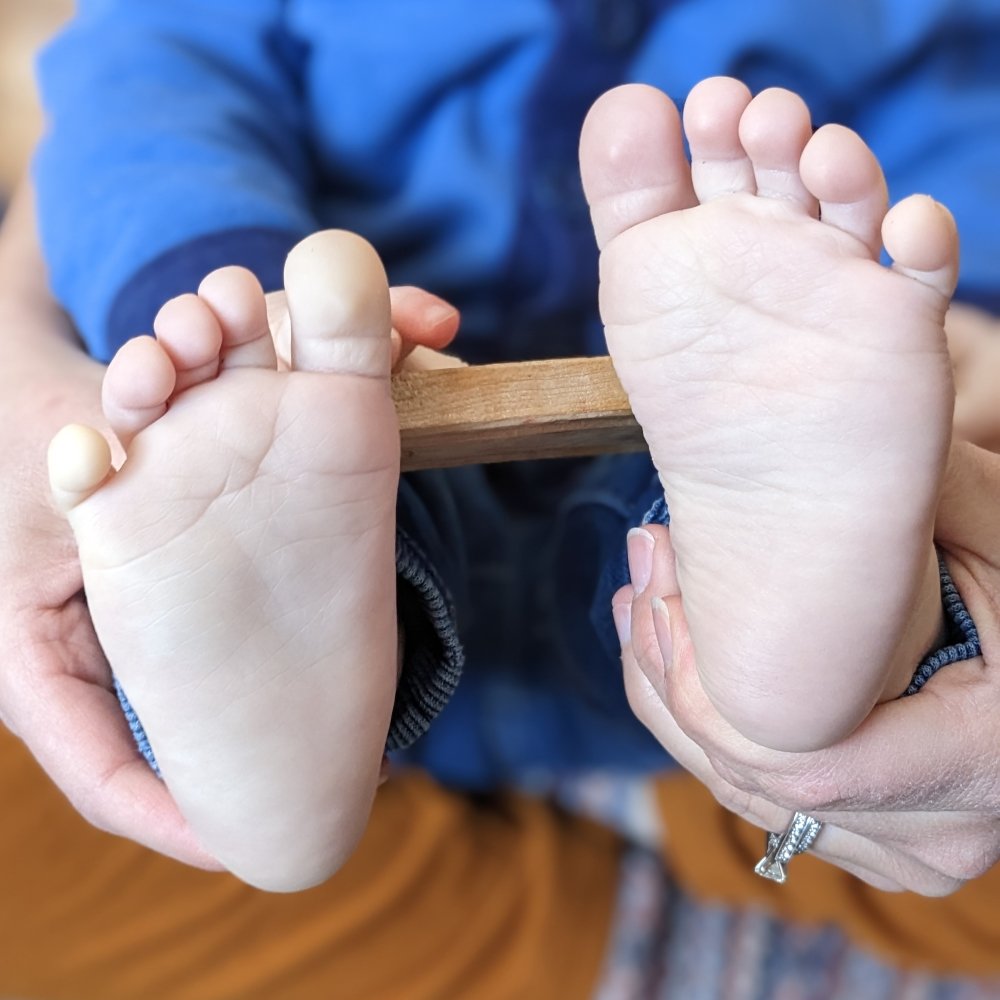
Babies should be kept barefoot as much as possible. But when it comes time to find your baby shoes, keep an eye out for options that are very soft, flexible, and thin so baby can sense the world through their feet. They have no need for shoes with any structure!
Fortunately, many baby shoes are already barefoot approved so you don’t need to be limited to my list. Once you know what to look for you can pass on any options that are not totally soft and flexible!
But here are a few of our baby and toddler barefoot shoe brands:
- Softstar Shoes (US)
- Starry Knight Design (US)
- Zutano Booties (US)
- Jack & Lily (US)
- Posh Panda (CA)
- Robeez (US & CA)
- PaperKrane (AU) – ANYASREVIEWS for 10% off
- Magical Shoes (EU) – Sizes EU 18 and up. Use code ANYA for 10% off
- Tikki Shoes (EU) – Sizes EU 18 and up
- Zeazoo Kids (EU) – Sizes EU 16 and up. Use code ANYASREVIEWS for 5% off
- Wildling Shoes (EU) – Sizes EU 18 and up. Use code AWN_ANYA_S for a one time free shipping offer. If you live in the US/Canada, shop Wildling Shoes here.
Looking for winter boots for littles? Here are my top picks for keeping tiny feet dry without weighing them down:
- Jan & Jul (US & CA) – Stay-Put Winter Booties for babies, Toasty-Dry Booties for toddlers (remove heel lift on insole to be zero drop)
- Jack & Lily (US)
- Wildling Shoes (EU)
- Stonz (CA) – Waterproof covers with optional fleece linings. Code ANYASREVIEWS10 for 10% off
For a list of our personal favorites, read the Best Barefoot Shoes for Babies and Toddlers article

Does your child wear a uniform with strict shoe requirements? Check out this list of barefoot shoes in all-black and all-white to wear with a school uniform.
All Black Shoes
- BGreater – Sizes UK i3-j6. Affordable and has a patent mary jane option
- Conker Shoes – Sizes UK 1-5.5. Be sure to choose a barefoot sole. Each pair includes a free half size stretching service and are also resoleable and repairable.
- Feelgrounds – Sizes EU 24-37
- Freet – Sizes EU 30-36. Get 15% off with my code AnyaFreet
- Magical Shoes – Sizes EU 27-35. Use code ANYA for 10% off.
- PaperKrane – Sizes EU 19-42. Several all black styles! Use code ANYASREVIEWS 10% off
- Splay Shoes – Sizes US 8C-13M. Use code ANYASREVIEWS for 10% off. Read my Splay Reviews
- Softstar Shoes – Sizes US 6C-5Y
- Sole Runner – Sizes EU 25-35
- Vivobarefoot – Sizes US 5C-6Y. Use code ARVIVO20 for 20% off for 10% off
- Wildling Shoes – Sizes EU 23-35. Tanuki Umi and Flying Fox. Read my Wildling Reviews here. Use code AWN_ANYA_S for a one time free shipping offer. If you live outside the US/Canada, shop Wildling Shoes here.
- Xero Shoes Prio – Sizes US 12-4
- Zeazoo – Sizes EU 18-36. Use code ANYASREVIEWS for 5% off.
All White Shoes
- Origo Shoes – Sizes US 8T-4Y. Use code ANYA for 10% off.
- Softstar Shoes – Sizes US 6C-5Y (custom option)
- Ten Little – Sizes US 4C-13. Read my Ten Little review here
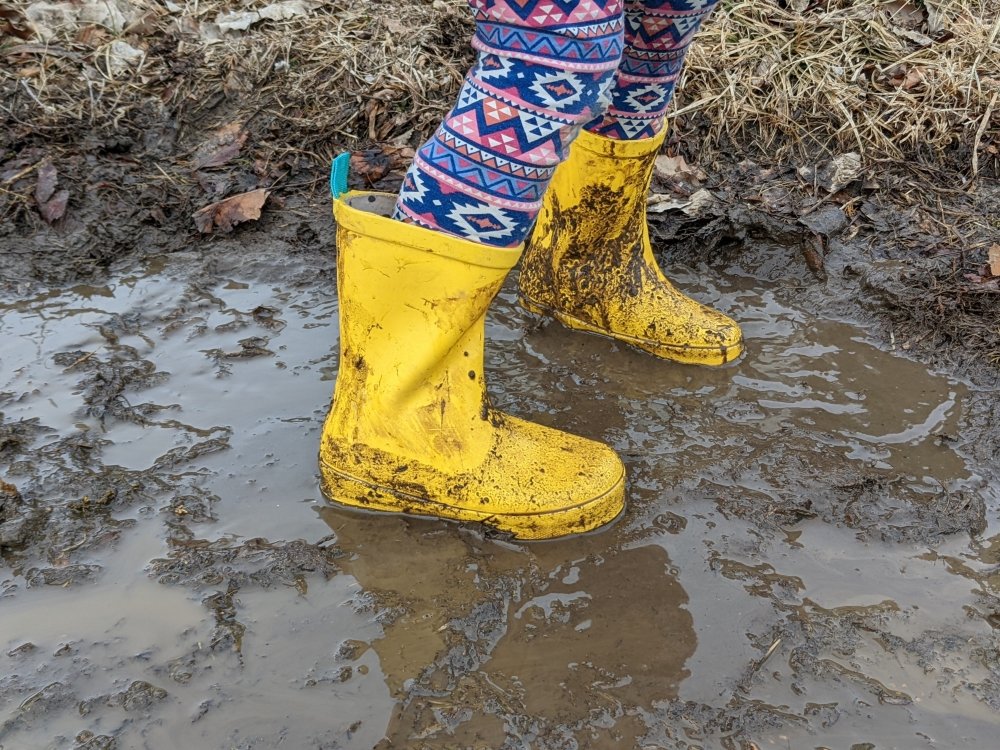
Yes! Heavy, heeled, clunky rain boots can be a thing of the past with these foot-friendly options. The following options are all barefoot-friendly rubber boots for kids, but keep in mind that some have a slightly tapered toe box. Bundgaard and Ten Little have the most foot shaped kids rubber rain boots right now.
- Wildling Ranidae – The same rain boot we love for adults, also comes in kids sizes! You can get a one-time free shipping offer with code AWN_ANYA_S. If you’re outside the US/Canada, shop Wilding Shoes here.
- Koel – These wellies also have a great toe box shape and are a good choice. We carry these at Anya’s Shop in the US!
- Saguaro – Sizes EU 24-34. Use code ANYASREVIEWS for 15% off
- Bisgaard – All zero drop except “Rain” model.
- Bundgaard rubber boots – All these wellies are zero drop except the Sailor boots. Customers outside the US can order directly from Bundgaard.
- Oaki Rain Boots – Rubber boots are zero drop, neoprene boots are not.
- Original Hunter Classic
- Ten Little – Toddler/little kid sizes US 6-13. Read the review here
Find a more complete list of kids waterproof barefoot shoes below! It also includes tips for waterproofing and sealing any barefoot shoes.

The options for barefoot shoes for big kids are getting better all the time. Here’s some of our favorite brands that bridge the gap between little kid and adult sizes.
- Be Lenka – Sizes EU 25+. Use code ANYASREVIEWS for 5% off. Read my Be Lenka Kids Review
- Freet – Sizes EU 30-36. Get 15% off with my code
AnyaFreet. Read my Freet Review - Magical Shoes – Size EU 18-35. Use code ANYA for 10% off.
- Mukishoes – Sizes EU 24-35. Use code ANYAMUKI for 5% off
- Origo Shoes – Sizes 8T-4Y. Use code ANYA for 10% off.
- PaperKrane – Sizes EU 16-42. ANYASREVIEWS for 10% off
- Softstar Shoes – Sizes infant-Youth 4
- Sole Runner – Sizes EU 25-35
- Splay – Sizes US 8C-M13. Read my splay review here! Get 10% off with code ANYASREVIEWS
- Tikki – Sizes EU 19-39. Read my Tikki review here
- Tadeevo – Size EU 31-36. Use code ANYASREVIEWS for 5% off
- Vivobarefoot – Sizes US 5C-6Y. Use code ARVIVO20 for 20% off for 10% off
- Wildling Shoes – Sizes EU 19-35. Read my Wildling Reviews here. Use code AWN_ANYA_S for a one time free shipping offer. If you are outside the US/Canada, use this Wildling Shoes link.
- Xero Shoes – Sizes US kids 12- 4Y
- Zuna Shoes (US only) – Sizes US 12-4Y. Read the Zuna review here
There aren’t a lot of options, but here are a handful of foot-shaped socks for kids!
- Amazon – This is one of the only places I’ve found toe socks for kids
- Plus12 – My boys don’t like toe socks, but they love these anatomical socks! You can also order Plus12 from Wildling Shoes
- Magical Shoes – 99% Merino wool socks with a wide toe box and non-skid bottom. Use code ANYA for 10% off
- Foot Buddy – Tube socks with no heel cup and relaxed toe box. Use code ANYAS15 for 20% off
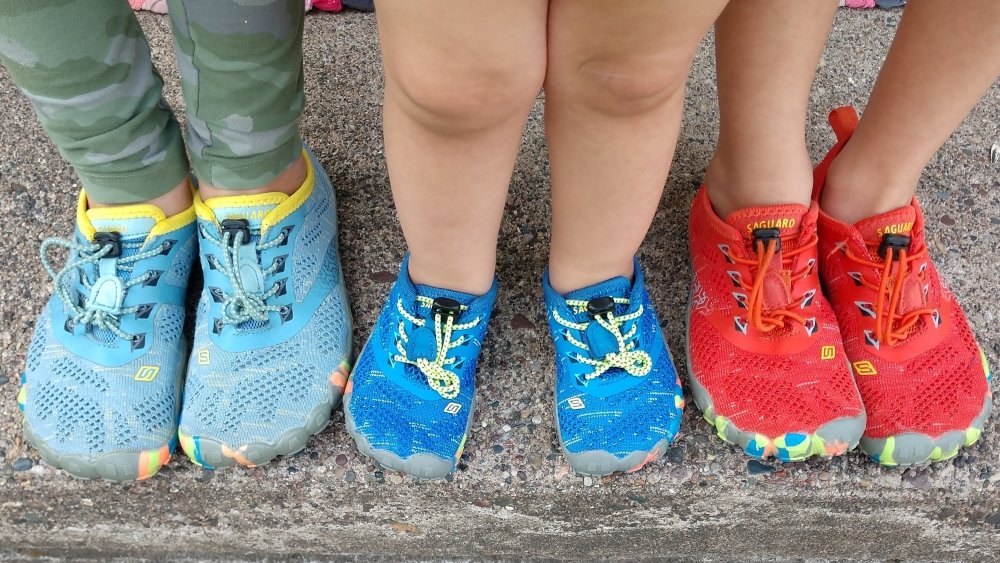
Yes! You don’t have to sacrifice your budget for foot health. Here are my top 3 picks for affordable barefoot shoes for kids.
- Splay – ANYASREVIEWS for 10% off. Read my Splay reviews here
- Saguaro
- Whitin
- Origo Shoes – ANYA for 10% off
- Cior Water Sandals
Read more about these in my Best Barefoot Shoes for Kids article!
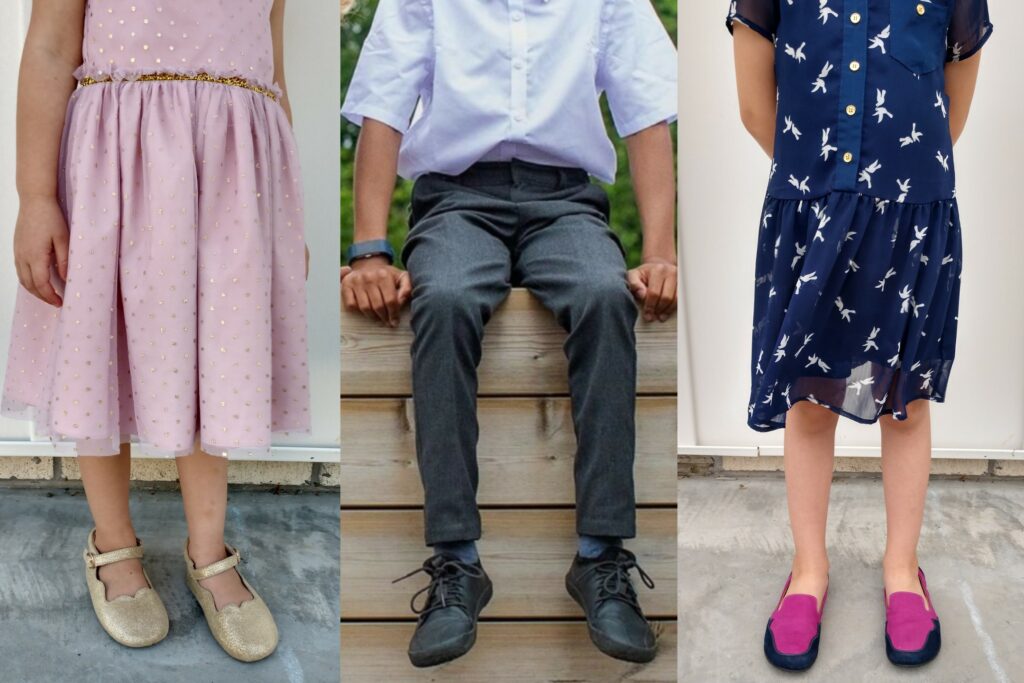
If your kiddo needs to dress up for a special event, but you don’t want them to complain constantly about being uncomfortable – barefoot dress shoes for kids is the answer! Or maybe your child needs color, sparkle, and glitz in their life – these brands look fancy, but feel comfortable for little feetsies. Here are some of our favorites:
- Vivobarefoot – Black mary janes and lace ups in sizes US ARVIVO20 for 20% off for 10% off
- Little Love Bug Company– Affordable and cute options for ballet flats and oxfords
- Ten Little – We like their mary janes and ballet flats!
A common concern I hear from parents is whether barefoot shoes are durable enough for kids’ play. Especially because quality barefoot shoes can be expensive, this is a valid concern. In this article on the Best Barefoot Shoes for Kids we specifically address which brands are the most durable so you can best decide! In my experience, the durable kids barefoot shoes we recommend are comparable to regular kids shoes in their longevity.
But it’s important to remember that shoes bear the brunt of all our activities – we really put them through the wringer standing, running, hiking, and playing on the rough ground in them. Dirt, scuffs, and wear are a natural part of using shoes.
Depending on how your child moves and their preferred activities you might experience wear more or less quickly than others, and there are always a few duds in the might mix that break down prematurely. So while we’ve done our best to accurately test and review the shoes here, it’s always possible you have a different experience.
If the main concern for you is the cost of having to replace shoes, check out My Favorite Budget Barefoot Shoes for Kids for a lower cost entry point.
Some people have heard that it’s bad to wear used shoes because the sole might be worn unevenly. But when it comes to barefoot shoes, that advice need not apply. Barefoot shoes are already thin, flat, and flexible so wearing them doesn’t result in deformation of the sole.
That means you can safely pass down barefoot shoes to multiple children until they completely fall apart!
If you are concerned about fungus or bacteria, simply hand wash the shoes with vinegar and/or baking soda than dry them thoroughly (I use a vent dryer).
Picking out a kids barefoot shoe size can feel daunting. But because they are growing (and each brand’s sizing is different) it’s always best to use current foot measurements to select a size based off the brand’s size chart. You want your child to have a minimum of 12mm extra length in their shoes, so that means new pairs can have up to 17mm extra length for growing room.
Here are my best practices for measuring kids’ feet:
- Measure twice just in case.
- Measure both feet and order based off the larger foot.
- Measure in the evening when feet are largest.
- For wiggly kids or very young kids, it can be helpful to tape your paper to the floor.
- Make sure your child is standing and putting their weight on the foot you are measuring.
- If you plan on having them wearing socks, make sure you measure with the socks on.
- Add about 15-17mm to foot length to find the internal shoe length you should aim for (plan on less than sandals, and more for boots)
Below is a video that explains two ways to measure your child’s feet. I like the wall method best because it is most accurate, but I usually do both to compare.
Once you have your measurements, read this FAQ on how to use a size chart to select a size!
The good news is flat feet is normal in babies and children and will usually develop into fully functional feet overtime. In fact, the extra fat in the midfoot of small children is protective! Reducing impact on the still-developing bones. Kids don’t usually develop a visible arch until around age 6 or 7, after the extra fat has disappeared.
And even then you don’t need to rush in with arch support if they still have flat feet. As long as your child has no diagnosed musculoskeletal issues and is developing normally it’s best to let them use their feet so their muscles and tissues can strengthen naturally.
Bernie Landels’ book Finding Their Feet is a great place to learn all about a child’s developing foot.
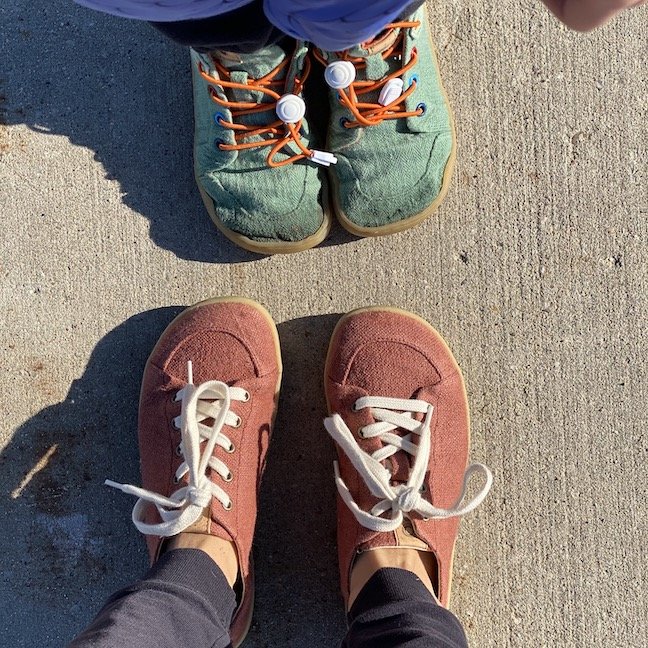
The beautiful thing about kids wearing barefoot shoes is that most of them don’t need to transition. Their feet came equipped with everything they need to support themselves! And because they haven’t yet spent years in restrictive footwear that ability is usually still available to them. Most children are able to start wearing barefoot shoes without skipping a beat.
If your child is older and has already been using supportive, heeled footwear (especially for athletics) then they may need more time to adapt to barefoot shoes. Sore feet and legs at the end of the day after wearing barefoot shoes are an indication they need to take it more slowly. For my best transition advice, check out the FAQ on How To Transition To Barefoot Shoes.
If your child is needing a transition period, check out these Kids Transition Barefoot Shoe Brands:
- Joe Nimble
- Lems – Not technically kids sizes, but the smallest size is Men’s 3/Women’s 4.5 which is about an EU 34.
Otherwise, you can start checking out barefoot shoe options for kids.
Kids feet are constantly growing, and it can be hard to know how often to check their shoes and order new ones. Ideally a child will have a minimum of 12mm of extra length in front of their shoes, so once they become shorter than that, it’s time to find a new pair. The best way to determine whether your child’s shoes fit is the Plus12 device, it works for adults too!
Sonja, a professional shoe fitter in the UK, recommends the following timetable as a rough guide for when to check your kids’ shoes:
- “First walkers – every four to six weeks.
- Toddlers and preschoolers – every six to eight weeks.
- Primary school aged children – every three to four months.
- Secondary school aged children – every five to six months.”

Many kids are able to continue to use their barefoot shoes for casual sport play! Our personal favorites are the:
- Vivobarefoot Primus Trail for all outdoor sports
- and Xero Prio for indoor sports!
But here are some more options for specific sports.
- Hiking
- Vivobarefoot Primus Trail
- Be Lenka Xplorer
- Xero Z Trail (hiking sandal)
- Baseball/Soccer
- Basketball/Court Sports
- Xero Prio
- Vivobarefoot Primus Sport
- Lems Primal 2 (big kids sizes)
Subscribe to the Barefoot Shoe Digest™
Stay up to date on all the best shoes, current sales, newest releases, and more
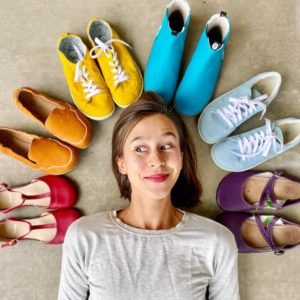
Hi. I'm Anya.
I first discovered barefoot shoes after a long history of foot issues. By changing my footwear and strengthening my body I was able to completely transform my life. Anya’s Reviews is my way of sharing with the world that healthy feet are happy feet!

